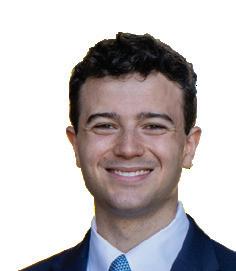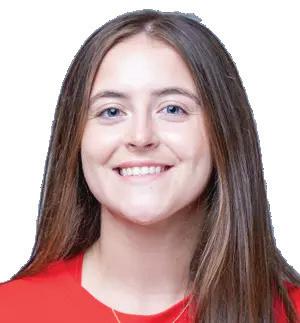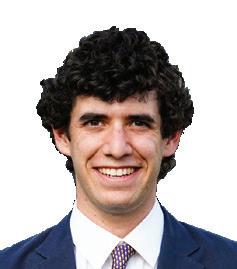The Corne¬ Daily Sun
142, No. 6
Kotlikoff and Bala The Sun sat down with the University President and provost to discuss federal funding, student detentions and AI. | Page 4


142, No. 6
Kotlikoff and Bala The Sun sat down with the University President and provost to discuss federal funding, student detentions and AI. | Page 4

By ZEINAB FARAJ Sun Features Editor
Oct. 14 — Thaddeus Lucentini ’29 died on Monday while home for Fall Break, according to a Tuesday morning email from Dean of Students Marla Love and Peter Loewen, dean of the College of Arts and Sciences.
The University did not state how the student died in the announcement.
Lucentini was from Shelburne Falls, Massachusetts and graduated from St. Paul’s School in June. He was planning to study history and was a member of the Army Reserve Officers’ Training Corps. Lucentini competed in alpine skiing, cross country and rowing for his high school, according to the email. He is survived by his parents.
“Our thoughts are with Thad’s loved ones, and we extend our deepest sympathies to his family, friends,
instructors, and classmates,” Loewen and Love wrote in the email.
The loss comes amid three other deaths impacting the College of Arts and Sciences, including Joselyn Guadalupe Garcia ’29, Senior Department Manager for the Department of Chemistry and Chemical Biology Michael Lenetsky and Prof. Debra Castillo, comparative literature.
“The College of Arts & Sciences has experienced the loss of four community members this semester,” Loewen and Love wrote in the email. “The passing of classmates and colleagues can affect each of us differently. We encourage you to care for one another and seek support when you need it. Losing a friend, classmate, or colleague is difficult.”
The University plans to hold a support meeting for the Cornell community at 6:30 p.m. on Tuesday, Oct. 14, in 413 Willard Straight Hall, or the Art
Gallery Room. An arts and sciences community meeting will also be held at 5 p.m. on Wednesday, Oct. 15 in G64 Kaufman Auditorium, Goldwin Smith Hall.
Individuals can have a diverse range of feelings, needs and reactions when facing loss. This information about Grief and Loss may be helpful to you or a friend. The Ithaca-based crisisline can be reached at 607-272-1616, and the 988 Suicide & Crisis Lifeline is available throughout the U.S. Additional support resources are listed at mentalhealth.cornell.edu.
Students in need of professional support can email Student Support and Advocacy Services at studentsupport@ cornell.edu or call Counseling and Psychological Services at 607-255-5155. Employees can call the Faculty and Staff Assistance Program at 607255-2673.
Zeinab Faraj can be reached at zfaraj@cornellsun.


By BENJAMIN LEYNSE Sun News Editor
Oct. 12 — Prof. Eric Cheyfitz, literatures in English, faced a two-semester suspension without pay after an investigation found he violated federal anti-discrimination law when he allegedly asked an Israeli graduate student, whom Cheyfitz claims was “disruptive,” to leave his course on Gaza.
Now, Cheyfitz is set to retire after he and his lawyer negotiated a deal to avoid further deliberation by a University panel and ultimately the president, a Cornell spokesperson told The Sun.
Cheyfitz’s undergraduate spring course AIIS 3500: Gaza, Indigeneity, Resistance, previously drew criticism from President Michael Kotlikoff for what he saw as a biased view of the ongoing Israel-Palestine conflict.
It was during that course, taught last spring, when Israeli graduate student Oren Renard filed a discrimination complaint with Cornell’s Office of Civil Rights. Since then, various University bodies have issued conflicting decisions.
The COCR’s initial conclusion of bias was overturned by a ruling by a Faculty Senate Committee, Cheyfitz said. Despite the committee’s ruling, Provost Kavita Bala moved to reopen the case and place it before a new hearing panel and ultimately President Michael Kotlikoff. This
was met with backlash from Cheyfitz and the American Association of University Professors over concerns of double jeopardy — the legal principle that prevents being prosecuted twice for the same offense.
Now, the investigation and hearing process launched by the provost has ended with Cheyfitz’s retirement, according to a University spokesperson.
“Professor Cheyfitz has chosen to retire and leave university employment, thus ending Cornell’s disciplinary process,” the statement reads.
Though no further disciplinary process action will be taken, the spokesperson explained that the COCR’s initial “finding of discrimination,” which held that Cheyfitz “violated Cornell policy and federal law,” would remain in place.
However, for Cheyfitz’s lawyer, Luna Droubi, the University’s statement is a “false account of what transpired,” because it fails to acknowledge the findings of the six-person Faculty Senate Committee on Academic Freedom and Professional Status of the Faculty. Droubi claimed that per University Policy 6.4, while the ruling from the Faculty Senate committee should have been binding, Bala chose to reopen the case.
By
Oct. 13 — In a room packed to full capacity, the Student Assembly voted to pass Resolution 10: Addressing the Administration’s Undemocratic Review of the Student Code of Conduct and Affirming Cornell’s System of Shared Governance in a 21-1-2 vote.
The Assembly also rejected their finance committee’s recommendations to reduce funding for ALANA Intercultural Board, Cornell’s Multicultural Greek & Fraternal Council and the International Student Association. Now, the finance committee will go back to the drawing board to reevaluate the organizations’ funding allotments and create new recommendations.
The vote followed a three-hour-long meeting filled with attendees’ stomps, claps, jeers and cheers that began with a visit from President Michael Kotlikoff and Vice President for Student and Campus Life Ryan Lombardi.
An Instagram announcement to “Pack the Vote for ALANA” by Black Students United, La Asociación Latina, South Asian Council, Native American and Indigenous Students at Cornell and ALANA garnered a crowd for the meeting.
ALANA is a supplementary funding board
that sponsors 138 other organizations and has funded over 117 events over the past two semesters. Approximately 130 students filled all seats and packed against the wall with over two dozen more waiting outside and peering through the windows.
When Kotlikoff and Lombardi walked into the room, the crowd erupted into a flurry of motion and noise as attendees picked up and turned their chairs to face away from where the administrators sat. Attendees standing along the walls also turned their backs on administrators. Many attendees held signs facing Lombardi and Kotlikoff in support of Resolution 10, ALANA, free speech, Palestine and more.
Kotlikoff and Lombardi’s discussion with Assembly members consisted of conversations surrounding updates on federal funding, Student Code of Conduct revision questions and more.
During a Q&A with members of the Assembly, Industrial and Labor Relations Representative Max Ehrlich ’26 asked about Prof. Eric Cheyfitz, literatures in English, and the due process behind the professor’s investigation — before ripping a printed copy of University Policy 6.4, the procedure for resolution of reports against employees in front of the administrators.
“Under the section for appeals to the committee on academic freedom and professional status, it says, quote, ‘The dean or equivalent unit head must accept the committee’s findings with fact and conclusions,’” Ehrlich said. “However, your University administration has overturned the committee’s findings in clear violation of your own rules of due process.”
Ehrlich then held up the policy and said, “So I guess I can just — ” and ripped the paper packet down the middle.
To continue reading, please visit www.cornellsun.com
Isabella Hanson and Dorothy France-Miller can be reached at ihanson@cornellsun.com and dfrancemiller@cornellsun.com
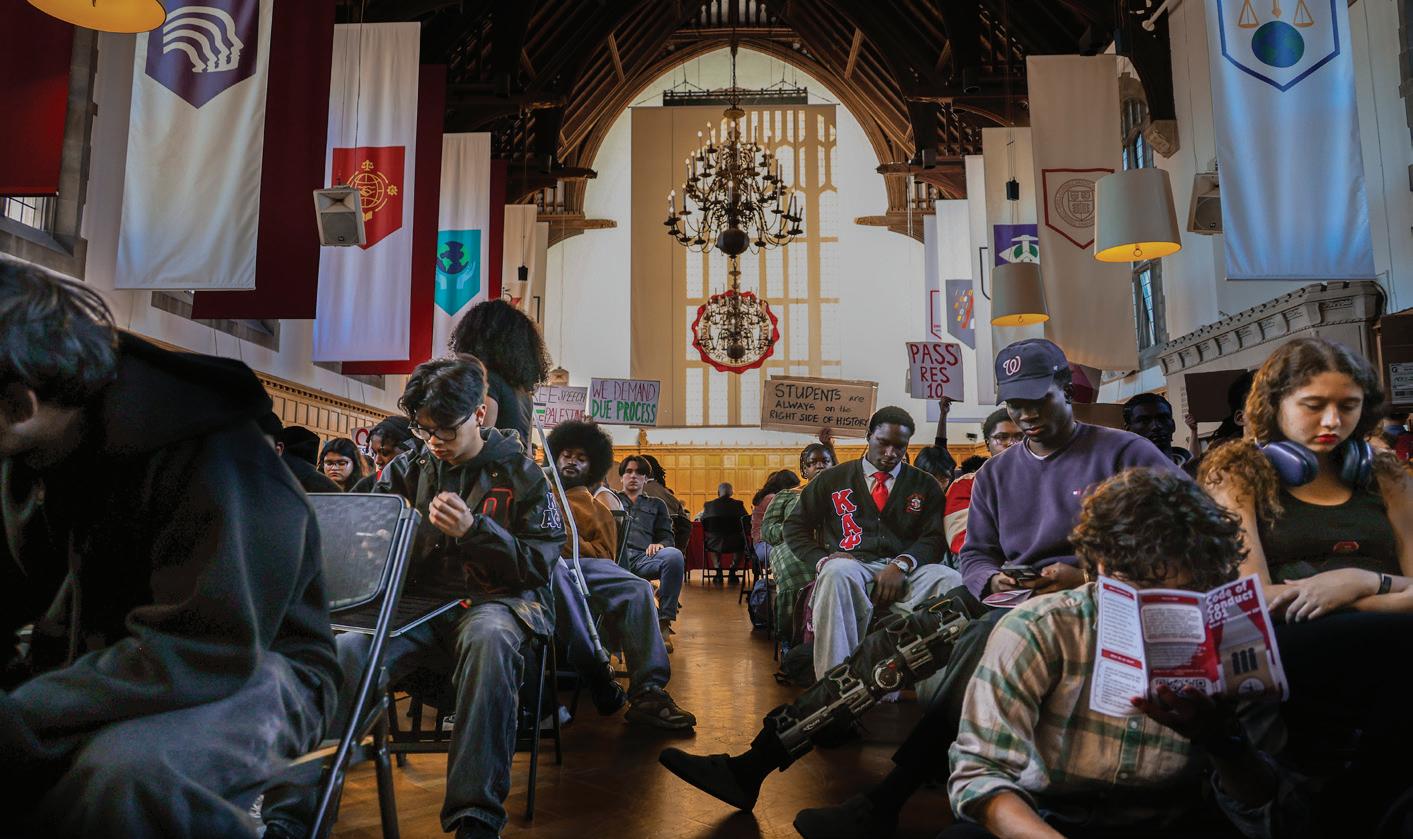








From chants and chair turning, to protest signs and pamphlets, to Greek letters and governance, Te Sun captured the scenes of Tursday’s Student Assembly meeting.
By SUN PHOTOGRAPHY DEPARTMENT
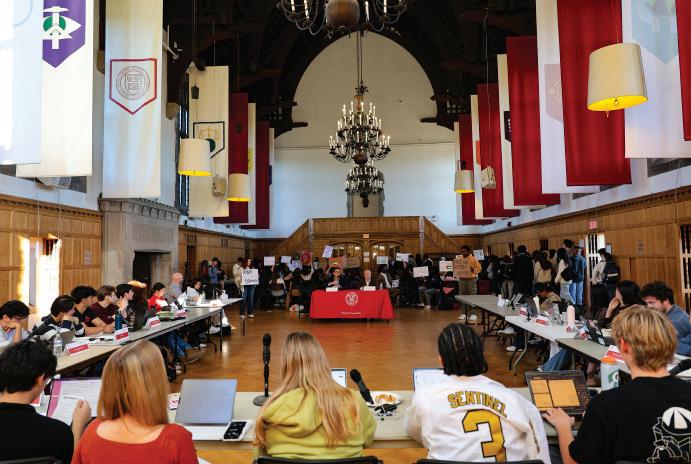
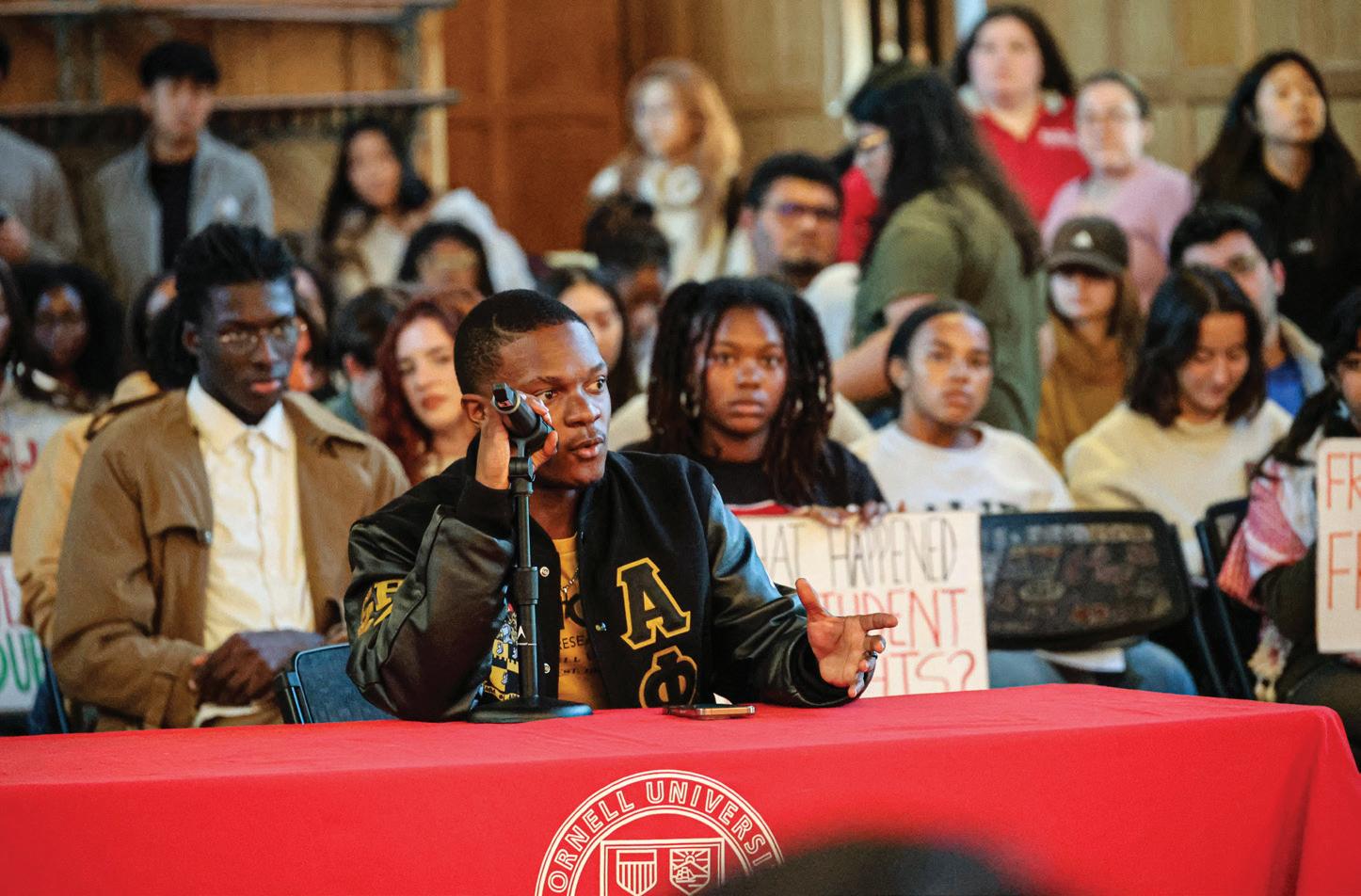
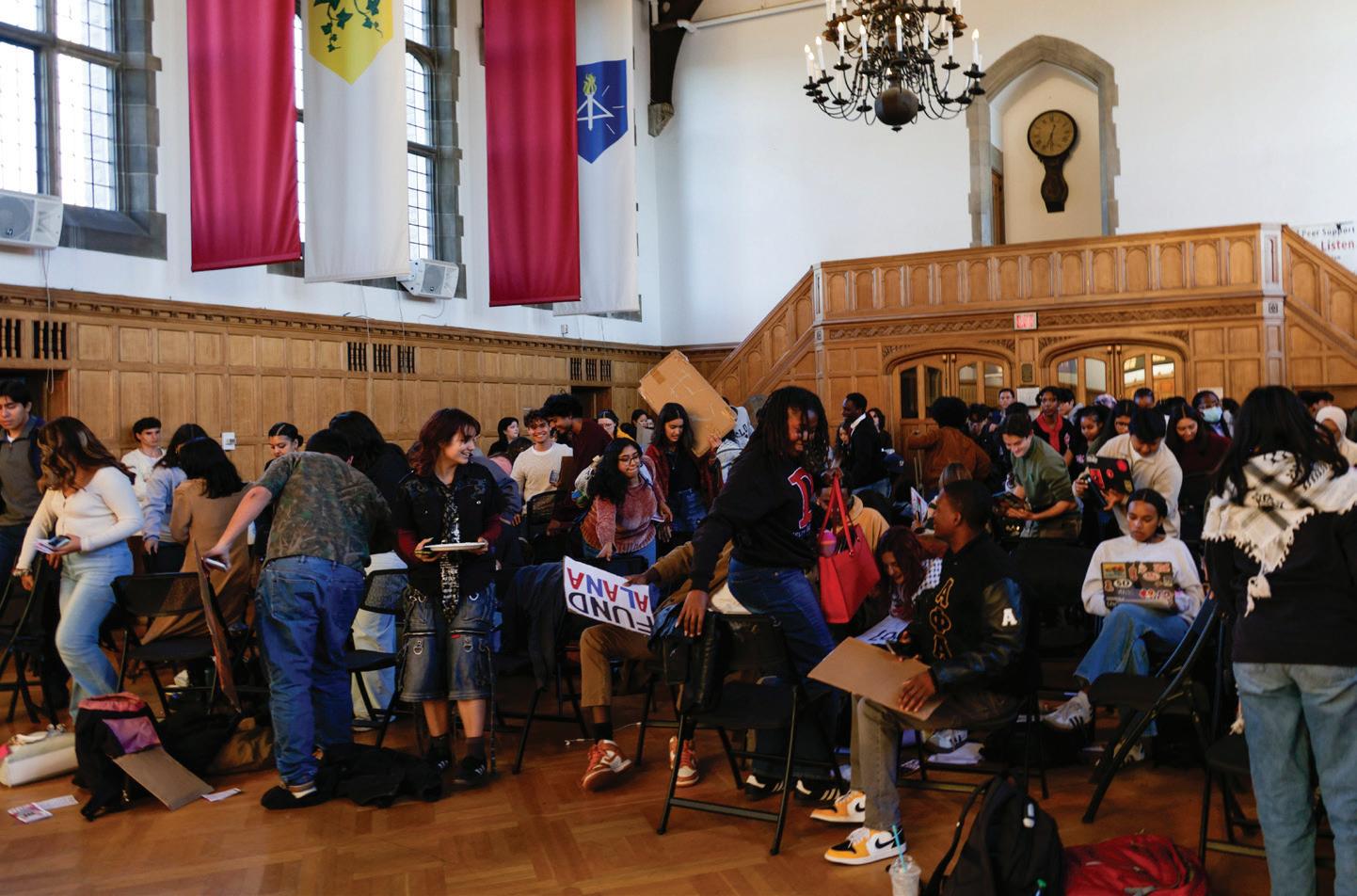
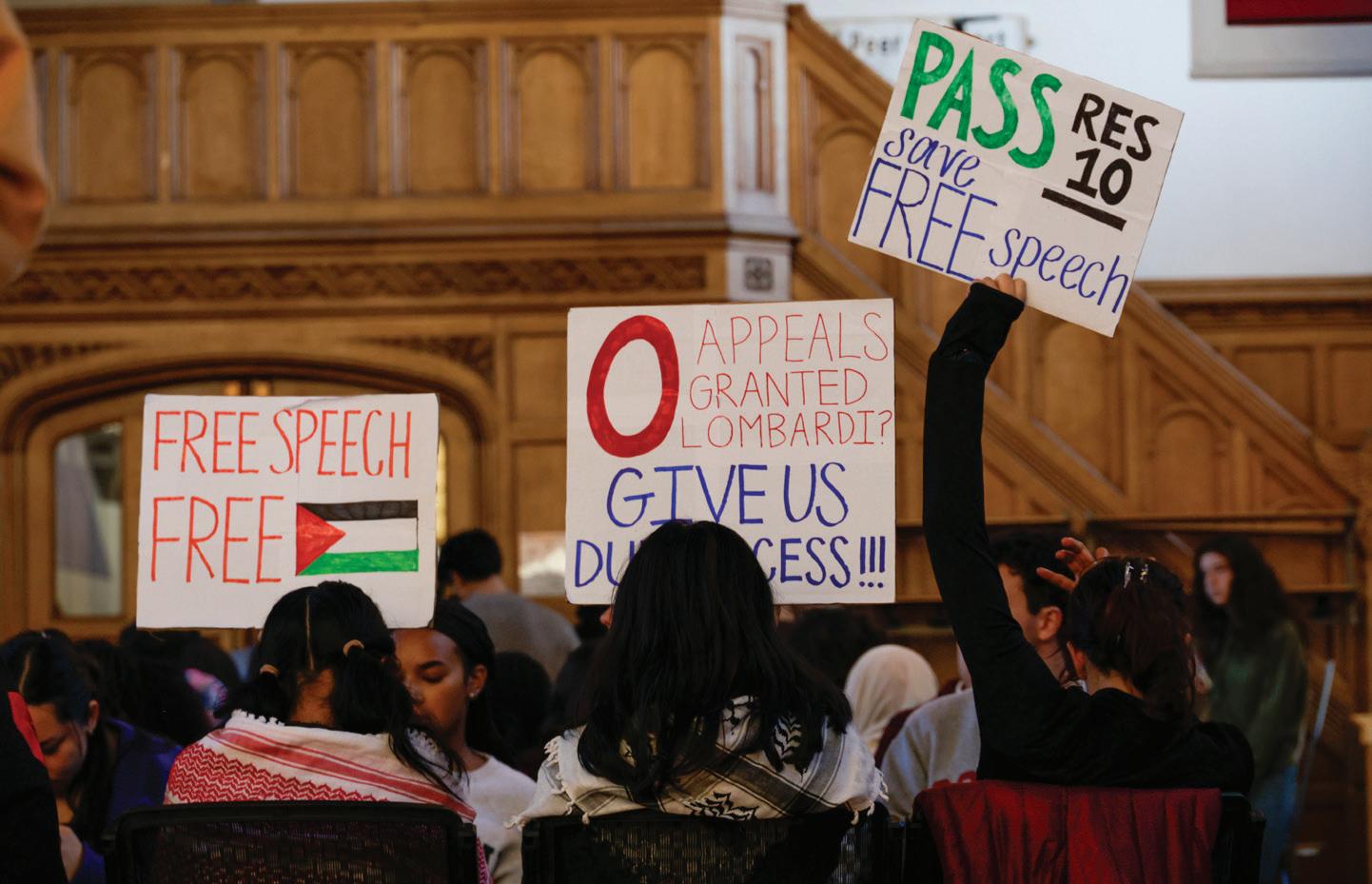
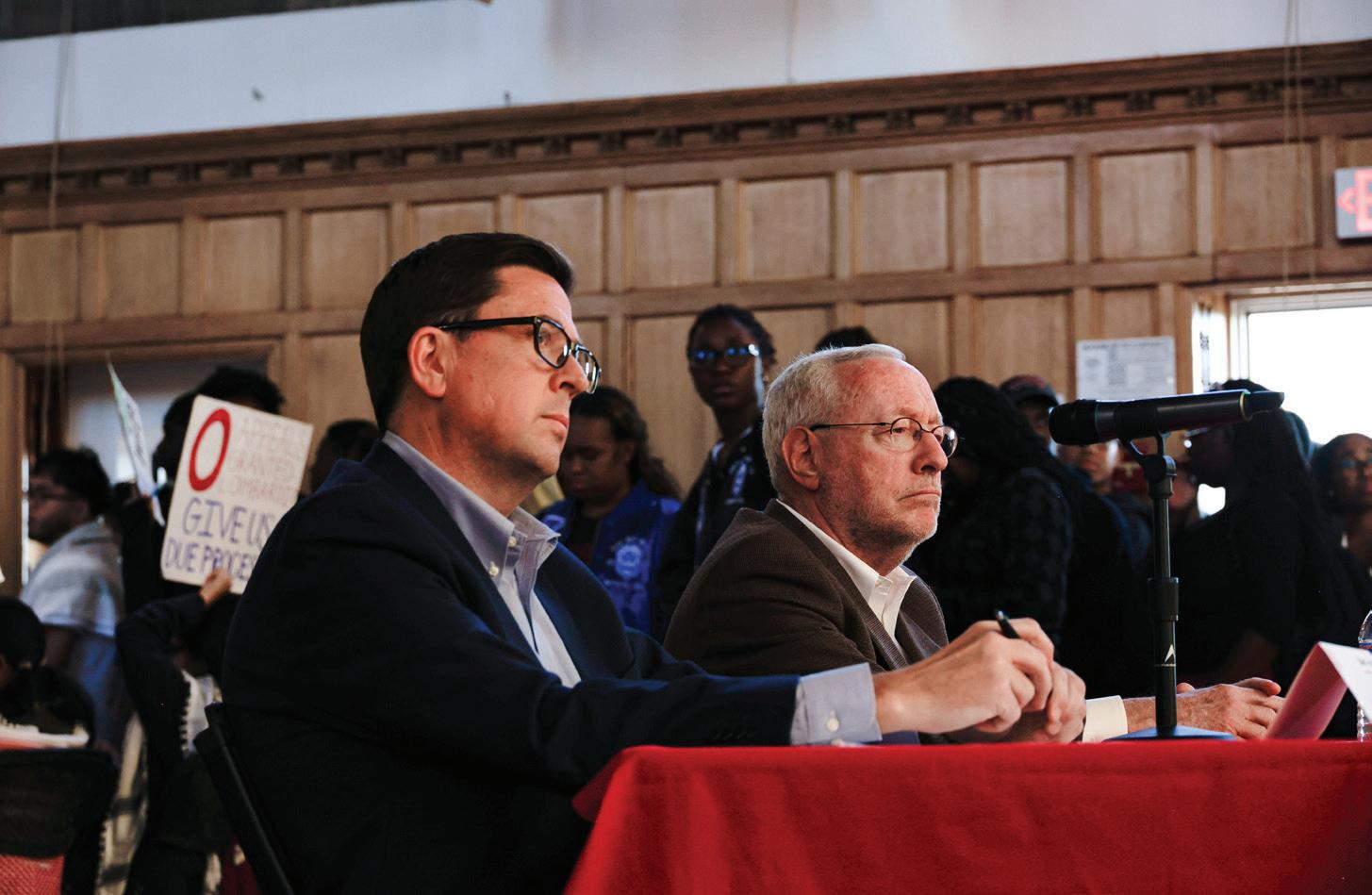
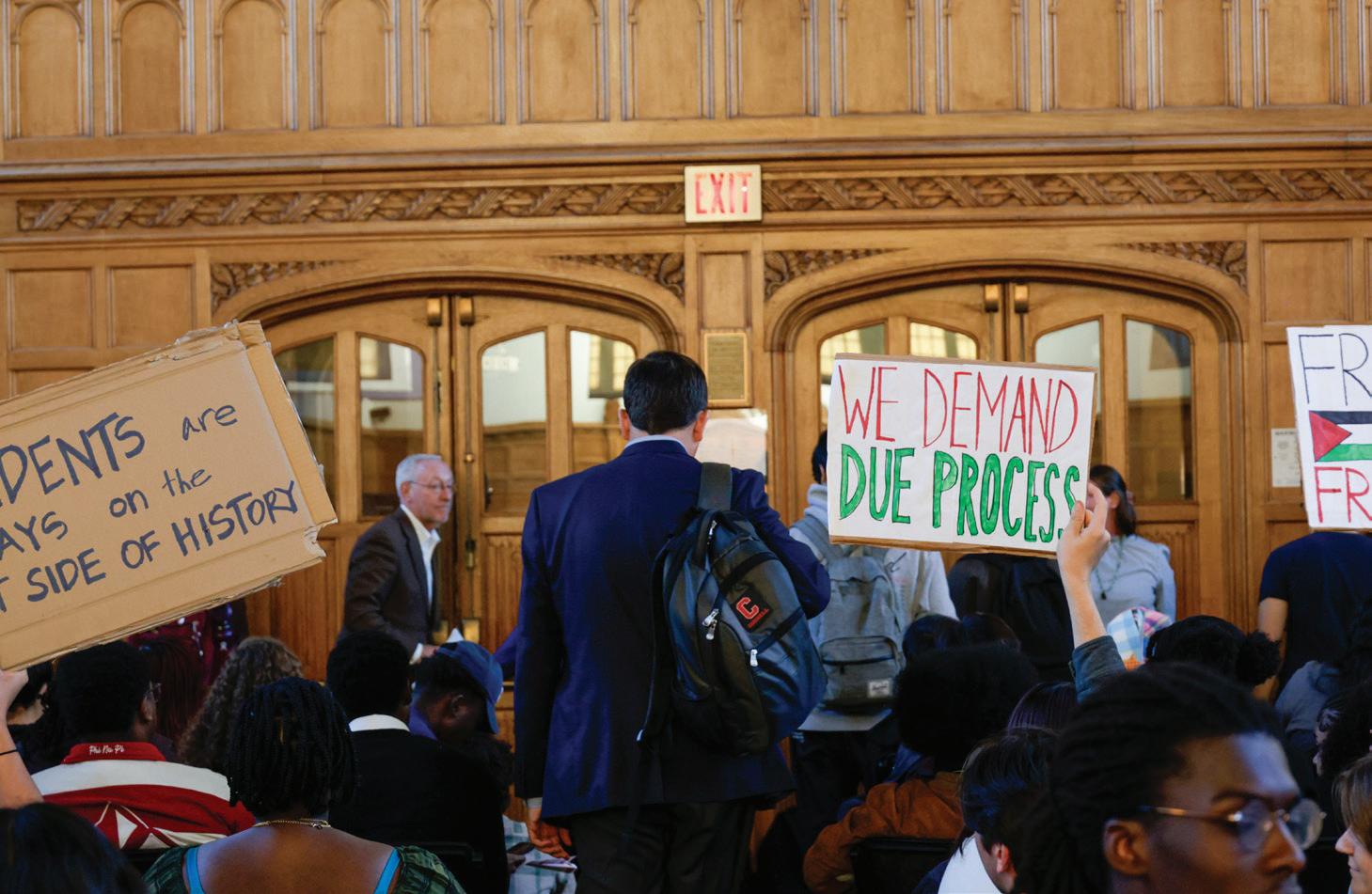
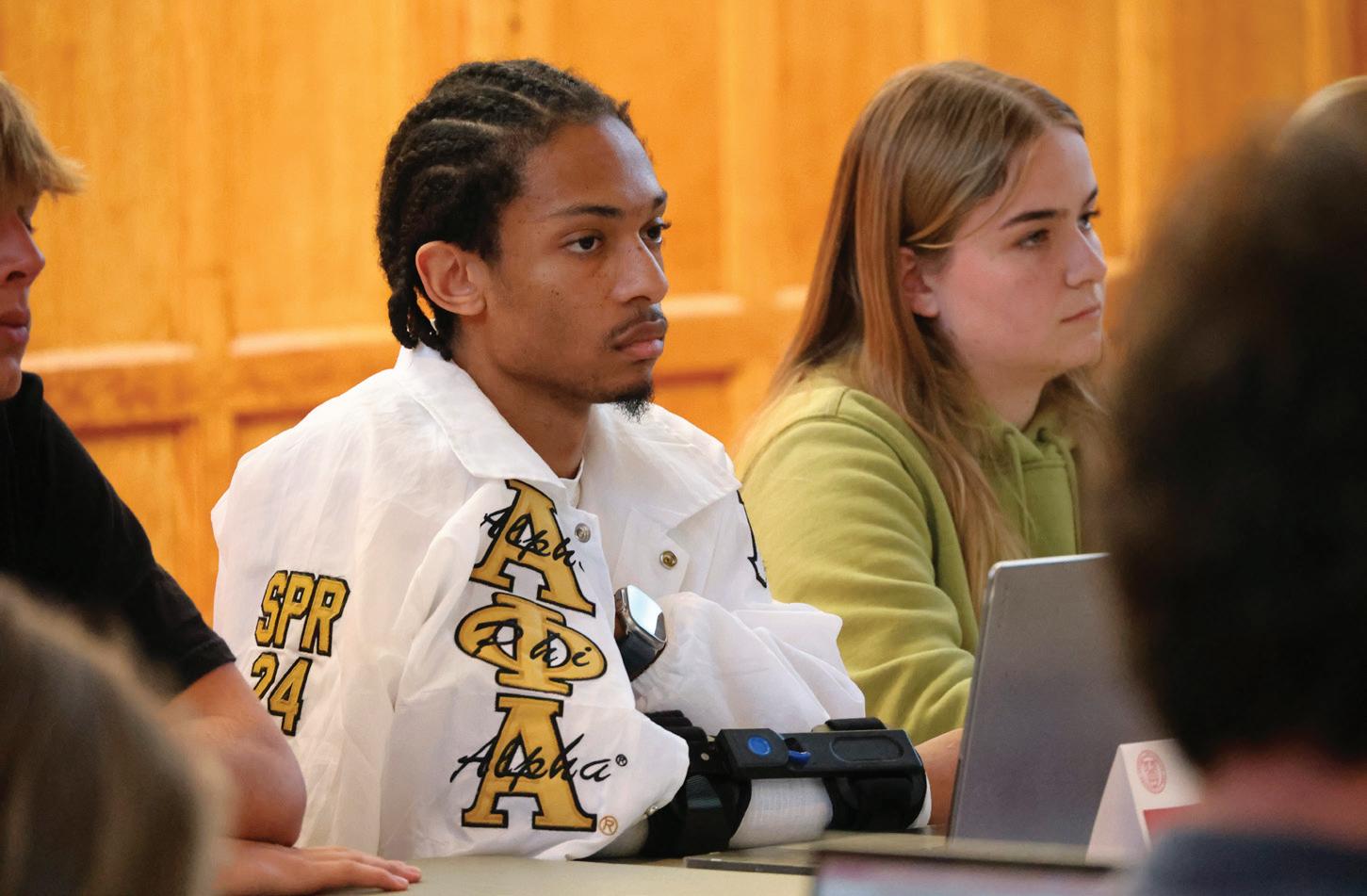
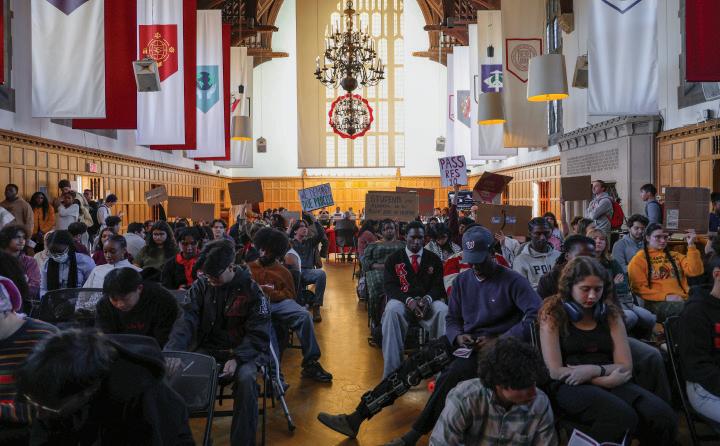
By DOROTHY FRANCE-MILLER and MATTHEW KIVIAT Sun Managing and Assistant Managing Editor
Oct. 9 — The Sun sat down with President Michael Kotlikoff and Provost Kavita Bala for an update on the ongoing challenges that the University is facing amid the Cornell funding freeze from the Trump administration since its last interview with the University’s top two administrators in May.
In the 45-minute interview, the administrators explained that around $80 million is owed to Cornell from the federal government for “programs for which we’ve made expenditures and we haven’t been reimbursed,” adding to the $250 million already cut by the Trump administration due to ongoing and continued stop-work orders. The Sun also questioned the administrators on reported body camera footage from the March Pathways to Peace event, ongoing litigation, University office name changes, sexual assault on campus, artificial intelligence and much more.
Below is the transcript of The Sun’s wide-ranging, exclusive interview with Kotlikoff and Bala. The transcript has been lightly edited, reorganized and condensed for clarity.
Pathways to Peace Body Camera Footage
The Sun: We recently reported that body camera footage from the Pathways to Peace event revealed that the chief administrator for the office of the president and provost, Kristin Hopkins, explained that someone referred to as “Mike” was hoping that the number of the detainments would be “more than eight.” Who was the Mike referenced in this instance?
Kotlikoff: Well, I assume that the Mike reference was to me, but the comment really referred to the fact that what we were trying to do was make sure that everyone that was at the event that violated our policies and prevented people hearing the speakers, and prevented the speakers from from essentially speaking, was identified and referred for appropriate violation of our policies. That’s what the comment, I believe, referred to, and wasn’t about arresting a certain number of people or certainly not doing anything to individuals that had nothing to do with violating the rights of others.
Funding Freeze
The Sun: So, on to the funding freeze and stop work orders. In our last sit-down interview with two of you in May, you told The Sun that there were approximately 120 stop work orders at the University, totaling approximately $250 million in federal funding cuts. Stop work orders remain after 90 days after the orders were delivered, meaning that the original orders from the spring semester would have expired or been extended by now.
So with that being said, can you provide us with an update on these stop work orders, including both the number of active stop work orders and the total funding cut through stop work orders? work orders.
were stopped stayed stopped. have two real the stopother the ment been that being we’re reim the
ously told us in the last interview that [beyond stop work orders] you [have to account] for the grants that have been canceled, as well as those that have not been paid. So could you tell us what the status of these grants that have not been paid by our interview in May, and then what and then accounting for both the stop-orders and grants, how much total federal funding has been cut from the University so far?
Kotlikoff: I think we’re in the range of $80 million that’s owed to Cornell by the federal government for programs for which we’ve made expenditures and we haven’t been reimbursed.
The Sun: Is that additional to the $250 million?
Bala: Yes.
Kotlikoff: It’s in addition to the stop-work orders.
The Sun: So the stop-work orders remain at $250 million, and now there’s about $80 million in grants?
Bala: $250 million was stop-work orders and terminations. And we’ve had a few more terminations since then that have come in, not in that big wave, but that’s the approximate range.
The Sun: Terminations of grants?
Bala: That’s correct.
The Sun: Sort of relating to that, how much money has the University been paying out of pocket to support research due to the funding that has been pulled?
Bala: I don’t have an exact number there. I’ll talk about different mechanisms we’ve used to support. So, there is a Provost’s [Research] Resiliency Fund, which we use that to give funding, not the full grant amount, but a small amount of bridge funding to the terminated grants so that they can find a bridge to a new source of funding. So that’s one mechanism.
Additionally, the colleges and the departments and the principal investigators, the PIs, all found funding for, particularly the stop-work orders, if a student happened to be on a graduate assistantship and they had to be put on a [teaching assistant] TA or they had to put on discretionary funds, that has also been taken care of or supported through these various units. And it’s distributed across the whole campus. And those are sort of the main mechanisms. I don’t have an exact number.
Kotlikoff: I just add to that, the [National Institute of Health] grants and [United States Department of Agriculture] grants are not being paid. Those are ongoing, so the University is back-stopping those grants.
The Sun: In August, Bloomberg reported that Cornell was in active talks with the Trump administration to reach a settlement of up to $100 million. And according to reporting from the New York Times as well, in September, talks have now stalled. So was the reporting about settlement talks, both in their existence
sions process, including students’ race, GPA and standardized test scores to the federal government. Penn agreed to reconcile its policies of transgender inclusion in sports with those of the Trump administration. And then Brown agreed to pay $50 million to a Rhode Island workforce development organization over 10 years to adopt the Trump administration’s definition of male and female for housing and athletics.
So with that said, was there anything [that] other institutions agreed to that you are not willing to compromise on in settlement talks?
Kotlikoff: Well, let me just say, I don’t want to speak about other university settlements, but let me just say that the notion that the federal government would control the University’s policies, would tell us how to enforce our policies, how we hire people, who we hire, how we admit students, who we admit — that is all beyond the appropriate relationship between the federal government and the University.
So for that, we would not agree to terms that place the federal government in an intrusive position relative to a private university.
The Sun: Seeing Harvard in their federal court win against the Trump administration for freezing more than $2 billion of federal research grants — is Cornell pursuing, or considering, to pursue a non-settlement legal path to restore funding?
Kotlikoff: We’re in a different legal position than Harvard. Because we didn’t get a letter from the federal government outlining the rationale for their actions, which was really a First Amendment case that Harvard was able to turn around and go to district court. Because we haven’t received that, our legal options are different, and we’re told by our advisors that our most likely source of legal remedy would be the Court of Claims.
The Court of Claims doesn’t have the ability to provide [an] instant remedy, so what we would have to do is have a prolonged case with the Court of Claims, at the end of which, our funding would be restored. That’s still an option for us, but it’s not one we’ve chosen to pursue yet.
The Sun: So you said that the $100 million settlement did not come from someone at Cornell and did not really reflect reality. So what numbers was Cornell looking at for the settlement then?
Kotlikoff: I’m not really, I’m not going to get — … one of the things that Cornell’s done has been very disciplined about not negotiating in public and not leaking to the press. So I’m not going to talk about that.
The Sun: The Washington Post recently reported that the White House was developing a plan that could
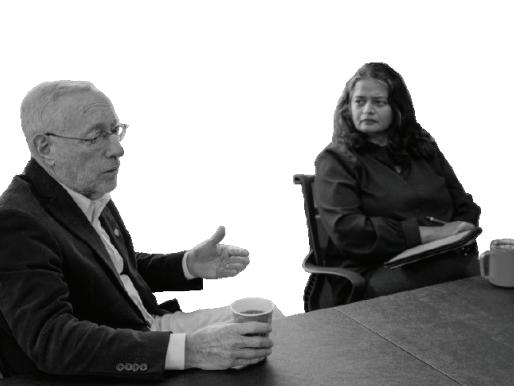
Continued from page 1
“The Administration now seeks to distract from their failure to follow their own policies by appealing to an earlier [COCR] finding based on less complete information,” Droubi wrote. Inside the Incident
Immediately after the first class Renard attended, classmates complained to Cheyfitz of his presence as the course’s only graduate student and of his pro-Israel speech during class discussions, according to Cheyfitz. By his third class appearance, he was asked by Cheyfitz to leave.
Renard, the Israeli student in question, is a Ph.D. candidate with a focus in computer theory. He previously served in Israel’s elite military surveillance agency, Unit 8200, according to reporting by The Nation about his LinkedIn profile. Renard’s LinkedIn profile no longer includes his time in Unit 8200, though it includes other cybersecurity work he did with the Israeli Defense Forces.
Cheyfitz claims that he initially welcomed Renard into the class, citing emails the two had exchanged where Renard told him he was Israeli. Cheyfitz, who identifies as Jewish and has a daughter and grandchildren who are Israeli citizens, noted that his personal relationship with Israel is “a very intimate one and not a hostile one.” He added, however, that his critique “is of the government of Israel,” which he labeled as conducting a genocide in Gaza.
The conduct of Renard in those initial classes is the subject of scrutiny for Cheyfitz.
Cheyfitz alleges that Renard recorded fellow students in class and noted that some students raised concerns over being doxxed. When asked by The Sun if he thought Renard purposefully enrolled in the class to surveil students, Cheyfitz answered: “Yes.”
Cheyfitz said he learned during the investigation process that Renard recorded the conversation in which he asked Renard to leave the class. Cheyfitz also said he saw Renard holding his phone during class, but could not otherwise confirm that he was recording during class time.
Sumitra Pandit ’26, a student in the course, also said that she did not notice Renard filming. However,
she said, “I don’t think I would have noticed if he had.”
Yet for Droubi, after Renard recorded his conversation with the professor, the possibility of doxxing was enough to justify asking Renard to leave the course.
“You look at the fact that he did, in fact, record Professor Cheyfitz. My point is, what else was he recording? ... What else was he surveilling?” Droubi said. “I think it’s a fair inference to assume that the students’ concerns [of doxxing] were legitimate.”
Under the Student Code of Conduct, all forms of recording to “appropriate, distribute, share, or use someone’s likeness, identifying personal data, or documents without permission” are prohibited.
Despite concerns over recording, when questioned by The Sun about the reasons for asking Renard to leave the classroom, Cheyfitz primarily focused on the students’ contributions to class discussions. Cheyfitz claimed that Renard was either “simply making contradictory comments” or “not participating in the discussion.” He also stated that he asked Renard to leave the class following peers’ complaints, because Renard was “upsetting my students, and appeared to be not doing the readings.”
Pandit, who is also a pro-Palestinian organizer on campus, shared a similar observation.
In the seminar of 10 to 15 people, she said, “It was pretty obvious that [Renard] was just there to argue with pro-Palestine students.”
Pandit also described how a Palestinian student she knew in the class dropped the course. That student said it was because of Renard’s “‘derailing the conversation’” in class, according to Pandit.
Renard did not respond to a request for comment by The Sun, though he previously told The Nation that he was “very concerned about the risks of having my identity disclosed online.”
Policy Tensions
The months-long investigation process had shown the tensions between academic freedom and the different disciplinary processes at Cornell.
Cheyfitz said that the original COCR investigation found his position “understandable,” and “that they struggled to come up with the conclusion they came up with.” The Sun could not independently confirm that this was the language of the COCR report,
By YUHAN HUANG and KATE TURK Sun Staff Writer and Sun Assistant News Editor
Oct. 10 — A resolution criticizing delays in temporary suspension cases for student protesters was stalled by the passage of a rare subsidiary motion in Wednesday’s Faculty Senate meeting.
President Michael Kotlikoff, Provost Kavita Bala and Vice President for Student and Campus Life Ryan Lombardi also fielded questions from faculty on a professor’s discrimination case, released body camera footage from the Pathways to Peace demonstration and the Code of Conduct review process. A Delayed Resolution
Faculty senators introduced the resolution “Concerning Excessive and Unreasonable Delay in the Conduct of Disciplinary Hearings and Providing for Reform of Procedures under the Student Code of Conduct.”
The resolution condemns the administration for its “unfair” execution of temporary suspensions. The resolution cites the eightmonth gap between the start of graduate student Sriram Parasurama’s temporary suspension for the September 2024 Statler Hall career fair shutdown and his disciplinary hearing in June.
The resolution calls for the Office of Student Conduct and Community Standards — which manages Student Code of Conduct enforcement — to be “independent of the central administration.” The resolution also urges revisions to the Student Code of Conduct, proposing a committee to review it comprised of three “freely-elected members” from each shared governance body.
The resolution comes amid controversy concerning a perceived lack of representation from several shared governance bodies on a recently-created Code of Conduct review committee, where members were appointed
and a University spokesperson stated that the COCR investigation found Cheyfitz was in violation of anti-discrimination law.
Cheyfitz said that the COCR then gave the matter to Dean of the College of Arts and Sciences Peter Lowen, who recommended to the provost that Cheyfitz receive a two-semester sanction without pay.
This sanction was appealed to the Faculty Senate’s Committee on Academic Freedom and Professional Status of the Faculty, Cheyfitz said.
Under the procedures laid out in University Policy 6.4, a faculty respondent can appeal the decision of the dean of their college to the Faculty Senate committee if they argue their conduct arose out of the typical student-teacher relationship.
The Faculty Senate committee unanimously found no violations of University policy, according to Cheyfitz. There was insufficient evidence to back up Renard’s claim that he was discriminated against for his Israeli identity, according to The Nation, which obtained the committee’s report. Cheyfitz claimed that Lowen then “overturned the finding of the constituted committee” and forwarded the charge to Bala, who reopened the investigation in violation of Policy 6.4.
The procedure of Policy 6.4 says that the dean “must accept the Committee’s findings,” though it adds that the dean “may modify the Committee’s recommended sanctions.”
However, speaking at the Faculty Senate on Wednesday, Bala said the reinvestigation was necessary since the Faculty Senate committee made its decision based on less strict standards than are federally required and used by the Cornell Office of Civil Rights.
“[The Faculty Senate committee] decided, based on its threshold, that there’s insufficient evidence of discrimination, but … we would be violating federal entry discrimination law if we accepted their finding based on that threshold,” Bala said. “This situation led to the actions that the dean and I took.”
Bala’s jurisdiction falls under a separate University policy, Faculty Handbook Section 6.6, which allows for a college’s dean to report the results of an investigation to the provost, who then holds the power to determine if future proceedings are warranted. It is under this policy that Cheyfitz was going to face a second hearing panel.
by the Cornell administration rather than elected by constituents.
Prof. Tracy McNulty, romance studies, said that the resolution’s sponsors proposed it two months ago, but did not hear whether they would be able to present it until “a couple of days” before the meeting.
In response to the resolution, the University Faculty Committee, a liaison between the Faculty Senate and senior administrators, presented a subsidiary motion. The motion recommended revisions that will delay voting on the resolution until November, such as the acknowledgement of the ongoing Code of Conduct revision process and the incorporation of relevant data from the Office of Student Conduct and Community Standards.
Prof. Tara Holms, mathematics, who is a UFC member, said in her speech that the current resolution is “dangerous for sound policy making,” criticizing the resolution as a violation of Parasurama’s privacy that “elevates a single case and misrepresents it as typical.”
Prof. Risa Lieberwitz, industrial and labor relations, described the motion as unusual and labelled it a “deflection” from the original resolution.
“I’ve never seen a subsidiary motion,” Lieberwitz said. “I’ve seen a motion to amend, but this is basically substituting this new motion for the original resolution.”
The subsidiary motion was put to a vote to the faculty and passed 36 to 30, with nine current senators abstaining.
To continue reading this article, please visit www. cornellsun.com.
Yuhan Huang can be reached at yhuan@cornellsun.com and Kate Turk can be reached at kturk@cornellsun.com.
Concerns Over a Fair Ruling
It is unclear whether or not University Policy 6.4 and Faculty Handbook Section 6.6 run concurrently with each other. However, under Section 6.6, the ultimate decision on the case remained with Kotlikoff. Kotlikoff previously attacked the course in private emails to a faculty member that were obtained by the Jewish Telegraphic Agency. He wrote in the email that he was “extremely disappointed with the [school] curriculum committee’s decision to offer the course.” Kotlikoff added that it presented “a radical, factually inaccurate, and biased view of the formation of the State of Israel and the ongoing conflict.”
When asked by The Sun if he felt like he was an objective source to decide Cheyfitz’s discrimination case, given his comments about the course, Kotlikoff said, “I don’t really have any bias.”
“These are two separate issues. One is whether a course should be open and objective or essentially dictate a certain definition or a certain interpretation of events, on the one hand,” Kotlikoff told The Sun. “My understanding of the issues you’re referring to — they’re really around the Title VI violation.”
Prior to news of his retirement, Cheyfitz was not hopeful that a positive outcome for his case could have been reached with Kotlikoff presiding.
“Why would I? Why would anyone feel [there will be] a positive outcome?” Cheyfitz said. “Would anyone feel safe with someone who had targeted them from the beginning?”
Those immediate concerns have now been averted with Cheyfitz’s negotiated retirement. However, for Droubi, this outcome remains an attack against his course. Cheyfitz said that under the agreement with the University, he began retirement on Tuesday and would receive pay for the spring semester.
“Professor Eric Cheyfitz taught a class entitled ‘Gaza, Indigeneity, and Resistance’ and was punished by the Cornell Administration for doing so.” Droubi wrote. “By choosing to resolve this matter with Professor Cheyfitz, the Administration has essentially conceded that they violated Professor Cheyfitz’s academic freedom.”
Benjamin Leynse can be reached at bleynse@cornell.com.
By BENJAMIN LEYNSE Sun News Editor
Oct. 9 — A draft report of the University’s Presidential Task Force on Institutional Voice was released Wednesday in an email to the Cornell community sent by task force co-chairs Deputy Provost and Prof. Avery August, immunology, and Dean of Cornell Law School Jens Ohlin. The report made recommendations to limit the content of what Cornell should speak on and distinguish individual opinions from that of the University.
The task force was formed last spring to evaluate “how and when the University should speak institutionally on matters of politics, ideology, current affairs, and world events,” according to a March 11 statement from President Michael Kotlikoff and other administrators.
The task force’s report comes as Cornell and universities across the country face scrutiny over their policies and content. Cornell has been reportedly in settlement talks with the federal government in an attempt to restore hundreds of millions of dollars of research funding that was frozen over pending antisemitism investigations.
The task force’s draft report recommends the University should show “institutional restraint,” stating that “it is not the place of the university or its leaders to speak about matters not germane to Cornell’s mission.”
Even when a topic did fall “squarely within the core mission of the university,” the task force maintained that Cornell was not required to comment. However, the report added that the University has the right to protect its interests.
“The university is entitled to protect its interests; neutrality with regard to itself is logically incoherent,” the report wrote.
“Institutional voice” describes any communication on behalf of the University, including
official statements, announcements of policies or events and speeches from the University’s president and provost.
In the past, the University has expressed viewpoints on a wide range of topics in University statements and has often weighed in on events of national importance. Under former President Martha Pollack, University statements condemned the Oct. 7 attacks in Israel, commented on the Supreme Court’s decisions overturning Affirmative Action and abortion rights, addressed the war in Ukraine and expressed sorrow and sympathy over the police killing of George Floyd.
As one of his first presidential actions, Kotlikoff announced in August 2024 that the president and provost would refrain from commenting on national or global events that do not directly impact the University. Since then, no University statements have been made on a national event unless it directly impacted Cornell.
The task force also wrote that the president and provost are the only leadership officials who represent the University, though at times, this status may be delegated to lower leaders.
The report then addressed leaders and groups at different levels throughout the University.
College deans, who do not represent the University according to the report, were told to be careful when speaking publicly, especially with “sensitive matters of political concern.”
The task force explained that for some a Dean’s public statements and their scholarly contributions are not easily distinguishable. The report stated that “deans should exercise restraint in their communications to avoid such confusion.”
To continue reading this article, please visit www.cornellsun.com.
Benjamin Leynse can be reached at bleynse@cornell.com.
JULIA SENZON ’26
Editor in Chief
ERIC HAN ’26
Associate Editor
SOPHIA DASSER ’28
Opinion Editor
ILANA LIVSHITS ’27
Assistant Opinion Editor
SOPHIA TORRES ’26
Advertising Manager
SYDNEY LEVINTON ’27
Arts & Culture Editor
JAMES PALM ’27
Assistant Arts & Culture Editor
JENNA LEDLEY ’27
Assistant Arts & Culture Editor
MELISSA MOON ’28
Assistant Arts & Culture Editor
SOPHIA ROMANOV IMBER ’28
Assistant Arts & Culture Editor
KAITLYN BELL ’28
Lifestyle Editor
MAIA MEHRING ’27
Lifestyle Editor
KARLIE MCGANN ’27
Photography Editor
MATTHEW KORNICZKY ’28
Assistant Photography Editor
STEPHAN MENASCHE ’28
Assistant Photography Editor
MIRELLA BERKOWITZ ’27
Video Editor
JADE DUBUCHE ’27
Multimedia Editor
HANNIA AREVALO ’27
Graphics Editor
HUNTER PETMECKY ’28
Layout Editor
RENA GEULA ’28
Layout Editor
CHIRSTOPHER WALKER ’26
Games Editor
DOROTHY FRANCE-MILLER ’27
Managing Editor
MATTHEW KIVIAT ’27
Assistant Managing Editor
VERA SUN ’27
Business Manager
EMILY LEE ’27
Marketing Manager
ALEX LIEW ’27
Human Resources Manager
BENJAMIN LEYNSE ’27
News Editor
VARSHA BHARGAVA ’27
News Editor
ISABELLA HANSON ’27
News Editor
CEREESE QUSBA ’27
News Editor
REEM NASRALLAH ’28
Assistant News Editor
ANGELINA TANG ’28
Assistant News Editor
KATE TURK ’27
Assistant News Editor
GABRIEL MUÑOZ ’26
City Editor
JANE HAVILAND ’28
Features Editor
ZEINAB FARAJ ’28
Features Editor
JEREMIAH JUNG ’28
Assistant News Editor
KAITLIN CHUNG ’26
Science Editor
MARISSA GAUT ’27
Science Editor
ALEXIS ROGERS ’28
Sports Editor
SIMRAN LABORE ’27
Weather Editor
Karim-Aly Kassam is an Opinion Columnist and professor in the Department of Natural Resources and the Environment as well as the American Indian and Indigenous Studies Program. His column Diference Matters recenters critical refection and environmental justice in campus life at a time when people turn away from the painful truth. He can be reached at karim-aly.kassam@cornell.edu.
The notion of revenge is present everywhere in our entertainment and political culture. Just think about all the films and television programs whose plot can be reduced to this base impulse: Under the pretext of obtaining justice, vengeance has become a poisonous brew that bubbles through our veins, generating an unquenchable obsession to indiscriminately hurt others.
William Blake, the 18th-century artist and poet, cautioned against the brutal effects of this obsession. Through the voice of “The Grey Monk,” the last verse conveys a warning.
The hand of Vengeance found the bed
To which the Purple Tyrant fled; The iron hand crush’d the Tyrant’s head
And became a Tyrant in his stead.”
Engaging darkness with darkness merely blinds our vision. We become the very thing we find abhorrent. The Old Testament edict, “eye for an eye,” is obsolete, without any humanistic value or relevance in the 21st century. Similarly, in 1948, Albert Einstein, Hannah Arendt, Rabbi Jessurun Cadozo and 25 other prominent Jewish community members sought to warn Americans of a dangerous trend developing in the newly founded state of Israel. In a letter to the editors of The New York Times published on December 4 of that year, they say with concern: “Among the most disturbing political phenomena of our times is the emergence in the newly created state of Israel of the Freedom Party,
Eric Han is a member of the Class of 2026 in the College of Arts and Sciences. He is the associate editor of the 143rd Editorial Board and was an arts and culture co-editor of the 142nd Editorial Board. His monthly column, Campus Dialectic, reviews recent Sun op-eds to speculate on cultural and political issues. He can be reached at ehan@cornellsun.com.
On Friday, The Sun published an op-ed by Professor Karim-Aly Kassam with his own artwork that included a bloodied Star of David and “SS” symbol on the back of a Palestinian subject. Following an internal Sun discussion, the op-ed, which discusses a pattern of Israeli officials describing Palestinians as “animals,” was retracted later that night and republished on Saturday with a different graphic. An editorial note was added on Sunday to clarify the temporary retraction.
An Instagram account called “Cornellians Only,” an anonymous social media publication, reported the incident later on Sunday, posting an image of Prof. Kassam’s face next to the bolded words, “Sun Publishes Professor’s Nazi Symbols.”
I write only on behalf of myself, one among five managing-level editors at The Sun, and not the organization in general. I write with concern for the wellbeing of Prof. Kassam, an adamant anti-Nazi columnist under my oversight as associate editor of the publication, and our campus community at large.
It is clear from both Kassam’s explanation to me, as well as Cornellians Only’s own interpretation of the art, that the SS symbol in this artwork carries a presumably negative connotation. Kassam’s op-ed advocates for the humanity of Palestinians, and the art clearly depicts that the Palestinian subject has been violently (i.e. bloodily) branded with the SS symbol. We should make it abundantly clear that Kassam is not a Nazi and is deeply abhorred by Nazi ideology — this artwork would contradict his own advocacy if it were truly praising Nazism.
The Sun retracted the graphic on the grounds that it may at least cause a visceral harm to some readers. But this is not the concern raised by community members. According to Cornellians Only, “The painting’s combination of a core symbol of Judaism with the insignia of its perpetrators is a clear-cut example of Holocaust inversion, an anti-semitic trope that seeks to equate Jews and the state of Israel with the Nazis.”
ic interpretation is sound, it is still not definitive, and it is hugely assumptive to say that this was Kassam’s intention.
The controversy ultimately clouds judgment over the issue Kassam raises — clear evidence of dehumanizing language used to justify violence against the whole Palestinian population. A genocide occurs in front of our eyes, albeit stymied to some extent by the Gaza Peace Plan, and we have shifted the conversation to a more ambiguous problem of whether it is permissible to identify hateful imagery with hateful actions. Kassam recognizes a seriously credible issue in the actually stated identity of one ethnic group with animals. His critics instead believe the more pressing issue to be his mere analogy of one government’s genocide with another government’s genocide.
The incident also raises questions about threats levied against academic freedom on campus. Kassam is one of several pro-Palestine professors who have been disparaged for reasons related to his speech on Palestine but without engaging the actual argument. This semester, Professor Eric Cheyfitz retired in the face of a potential suspension for allegedly discriminating against an Israeli student in his class on “Gaza, Indigeneity, Resistance.” In a problematic violation of double jeopardy, Provost Kavita Bala’s reopening of his case came despite the Faculty Senate’s final and unanimous declaration of his innocence. The majority of students who took the class came to Cheyfitz’s defense, claiming that some of them had raised fears of being recorded or intimidated by the plaintiff.
In August, at least a plurality of American voters believed that Israel was committing a genocide in Gaza. It may be apparent to genocide apologists that there is no good way to dispute the facts — as Kassam demonstrates, Israeli government officials justified “collective punishment” of the Palestinian people on the grounds of at least some Palestinians’ “animal” nature. So, rather than engage with the actual substance of Kassam’s or Cheyfitz’s argumentation, critics might prefer to redirect the issue.
a political party closely akin in its organization, methods, political philosophy and social appeal to the Nazi and Fascist parties. The current visit of Menachem Begin, leader of this party, to the United States is obviously calculated to give the impression of American support for his party in the coming Israeli elections, and to cement political ties with conservative Zionist elements in the United States. … Before irreparable damage is done by way of financial contributions, public manifestations in Begin’s behalf, and the creation in Palestine of the impression that a large segment of America supports Fascist elements in Israel, the American public must be informed as to the record and objectives of Mr. Begin and his movement.” In the same letter, they went on to illustrate what these extremists were capable of unleashing upon Palestinians.
“A shocking example was their behavior in the Arab village of Deir Yassin. This village, off the main roads and surrounded by Jewish lands, had taken no part in the war, and had even fought off Arab bands who wanted to use the village as their base. On April 9, terrorist bands attacked this peaceful village, which was not a military objective in the fighting, killed most of its inhabitants 240 men, women, and children and kept a few of them alive to parade as captives through the streets of Jerusalem.” As leader of the Likud party, Menachem Begin finally became Israel’s prime minister from 1977 to 1983. The current leader of this party is Benjamin Netanyahu.
To continue reading, visit www.cornellsun.com.
To “equate” might mean to “make equivalent” or to imply similarity. If Holocaust inversion supposes that first meaning of the word, then Kassam makes no claim that Israel is wholesale equivalent to the Nazi regime. That Israel uses dehumanizing language “not unlike” that of the Nazis, or that one particular party in Israel is “closely akin” to the Nazi Party, does not imply that the state of Israel is equal to Nazi Germany. And, if it is indeed the case, as Kassam alleges, that some Israeli government officials refer to Palestinians as “animals,” I would find it very difficult to dispute the claim that the Israeli government is similar to the Nazi regime in this particular way. This is Kassam’s written argument, and I think it reflects his painting. This analysis further indicates the absurdity of disparaging Kassam for “equating” in the second sense of the word, to imply mere similarity — if we cannot say that a government which calls one ethnic group “animals” is similar to Nazi Germany in this way, then we are forever bound to intellectual dishonesty with regard to genocide. If the antisemit-
That the issue of Israel’s genocide in our campus discourse has become subject to more of a procedural discussion, not one that actually has to do with the people who are losing their lives and limbs in Palestine, is deeply frightening to me as one member of The Sun and a human being in general. Cornellians Only’s uncharitable and inflammatory representation of the op-ed and its associated graphic only complicates writers’ advocacy against the genocide and recent antisemitism (which may have proliferated from the undue association of the whole Jewish people with Israel’s genocide, an association that Zionists insist to preserve).
I deeply apologize to any of those who were affected by the publishing of the Nazi symbol. I understand that the imagery may have reminded readers of a truly traumatic history, and it should not have been published. To those community members: your humanity is intrinsic, and I will always defend it. Let us recognize the same humanity in all peoples of the world.

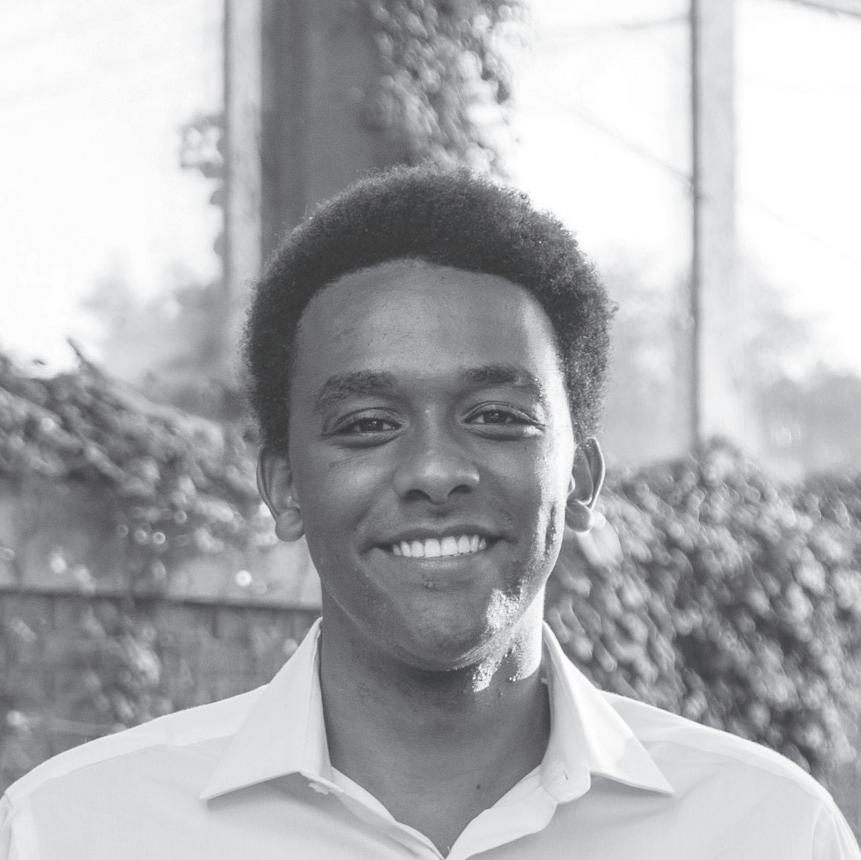
Yihun Stith ’26 is an Opinion Columnist and a Computer Science and Government student in the College of Arts & Sciences. His fortnightly column, Stand Up, Fight Back, explores the political structures and power dynamics that shape life at Cornell. Trough analysis, critique, and calls to action, the column challenges Cornellians to engage with the world beyond the campus bubble and to fght for a more just and accountable university. He can be reached at ystith@cornellsun.com.
Last week, Cornell University’s central administration suspended Dr. Eric Cheyftz, a Jewish Professor at Cornell for over 20 years, for alleged violations of federal antidiscrimination law. Last semester, in his course “Gaza, Indigeneity, Resistance,” which analyzes the historical and ongoing settler colonial violence against Indigenous peoples in the U.S. and Palestine, Cornell administration alleges Cheyftz told a graduate student to drop the course because the student is Israeli. However, after Cheyftz petitioned the suspension, the Faculty Senate’s Committee on Academic Freedom unanimously found that there was insufcient evidence to support these allegations. Yet, Arts & Science Dean Peter John Loewen and Provost Kavita Bala pressed the case forward anyway, overruling faculty judgment. In doing so, Cornell has weaponized the language of “civil rights” in a move that mirrors tactics used by the Trump administration to purge campuses of pro-Palestinian thought.
Tis incident is not in isolation. Since October 7, 2023, Cornell administration have vocally threat-

ened and distanced themselves from pro-Palestinian professors. Te most tumultuous case being that of Professor Russell Rickford, who described October 7 as "exhilarating." Professor Rickford's comment drew criticism from news outlets, students and politicians. Tis pressure led former Cornell President Martha Pollack and Kraig Kayser, former Board of Trustees chair and owner of a weapons manufacturing company, to quickly condemn Rickford and write, “they speak in direct opposition to all we stand for at Cornell.” Cornell had clarifed their overton window didn’t include Rickford’s rhetoric.
Not only was this a message to Rickford, but one to other professors and students. Besides being a clear betrayal of professors' academic freedom, Cornell’s words ring ever hollow after almost two years of geno- cide. Te UN ruled Israel has been conducting an “illegal occupation” and “genocide” of the Palestinian people. However, Cornell has not taken a stance on the war crimes, human rights abuses, and denigration of humanity the people of Gaza face everyday. Cornell has not punished any supporters of Israel’s genocide, of which there are many on this campus. Are genocide and its avid vocal supporters not in “direct opposition to all we stand for at Cornell?”
Rickford isn’t the only professor they are keeping an eye on. Te Cornell administration is watching all professors. In a secret meeting with parents from an explicitly Zionist organization, multiple Cornell administrators answered questions relating to pro-Palestinian professors and students. While discussing a professor with pro-Palestinian views, former VP of Communications Joel Malina said, “her in-class activities will be scrutinized, as will all in-class activities of our faculty.” Te Cornell administration has said the quiet part out loud. Tey will use Palestine as the pretext to overreach and control all academics. And this isn’t only rhetoric like our administration would want you to believe. Last January, a couple months after this meeting, Cornell instated University Policy 8.1 Physical Security Systems. Policy 8.1 gives Central Administration and CUPD access to “All cameras (Including academic and research).” Cornell is always watching.
In the case of Cheyftz, the Cornell administration, specifcally President Michael Kotlikof, was indeed
watching. In a released email, President Kotlikof ofered his scathing rebuke of Chetyftz’s “Gaza, Indigeneity, Resistance” course. Kotlikof wrote, “I personally fnd the course description to represent a radical, factually inaccurate, and biased view of the formation of the State of Israel and the ongoing confict.” In this context, the central administration’s decision to suspend Cheyftz is underlined by ulterior motives. A committee of Cheyftz’s peers not only concluded that he deserved no punishment, but that the case does not hold any water. Te only push for this punishment is coming from the very top.
In other words, the process worked until it reached the one place designed to be unchecked: the President and Provost. Te Faculty Senate, tasked with protecting academic freedom, unanimously rejected the claim. But those fndings were discarded. By stripping away the university’s own guardrails, Cornell’s leadership ensured they could punish Cheyftz anyway, dressing that punishment in the language of “civil rights” and “discrimination.” And this disdain for checks doesn’t stop at faculty oversight. Students are seeing the same disregard in real time.
Just last week, the Student Assembly debated Resolution 10, which condemns the administration’s unilateral revisions to the Student Code of Conduct. Students criticized the exclusion of elected governance bodies from the process and described a disciplinary system where suspensions are issued before investigations, appeals are universally denied, and months pass before students even learn the evidence against them. In the words of Assembly representative Aiden Vallecillo ’26, “We don't pass kindly worded resolutions hoping that our privilege of self-governance is respected. We pass strongly worded resolutions so that our rights are respected.” Te pattern is unmistakable: whether it is faculty academic freedom or student due process, shared governance is being hollowed out.
It is the same playbook now on display in Washington, where Trump invokes antisemitism to police pro-Palestinian thought. At Cornell, as in the country, “civil rights” have been emptied of their meaning and repurposed as a weapon of control. And if control is allowed to set the syllabus, the grip will only tighten.
is Important.
son with an average knowledge of sailing.
The proclamation goes on to say that he was guided by a “noble mission: to discover a new trade route to Asia, bring glory to Spain, and spread the Gospel of Jesus Christ to distant lands.” He wrote himself that he was driven by a desire for personal wealth and prestige through his voyages. He was also particularly eager to enslave the people he encountered, even when Queen Isabella of Spain, his beneficiary, was horrified by these suggestions.
an olive branch from the United States and as a federal recognition of the moral merits of Italian Americans. Though not directly relevant to ItalianAmericans before, it has been tied to them ever since.
Alternatives and the Future
Paul Caruso is an Opinion Columnist and a second year MPA student in the Brooks School of Public Policy. He is the founder of the Cornell Negotiation Student Society. His column, Caruso’s Compass, focuses on politics, international afairs, and campus life. Te column seeks to identify issues with the status quo and provide solutions to them. He can be reached at pcaruso@cornellsun.com.
On October 9, the Trump Administration published a proclamation offering a revisionist history of Christopher Columbus. Full of nationalist ideology rather than fact, the proclamation infuriatingly aims to suppress history. What I believe is worse is how it has forgotten why we have Columbus Day, and how irrelevant Columbus himself is to Italian Americans.
I argue that Columbus Day has never been, is not, and will never be about Columbus himself. A day should not be named after him, but the core reason behind the creation of the day is important and enduring. If we must name it after anyone, there are better Italians and Italian-Americans to choose from.
What the Administration Gets Wrong About Columbus
The proclamation states Columbus was “one of the most gallant and visionary men to ever walk the face of the earth,” as if to deify and protect him from “left-wing arsonists.” At no point does Columbus need left-wing arsonists to disrupt his legacy. He did it himself.
His diaries show that he miscalculated the true size of the Earth’s circumference and lied about his westward maritime route calculations to secure Spanish sponsorship for the voyage. No record — prior to the origin of Columbus Day — describes Columbus as anything other than an average per -
One thing that the proclamation gets right is that Columbus never found North America. Nor are the Americas named after him. Until 1507, it was believed that Columbus had discovered a little-known part of Asia, not the New World.
It was Italian explorer Amerigo Vespucci who originally dubbed the Western Hemisphere “Mundus Novus,” or New World. His purpose was different: he sought to map the earth and the sky and document new species as he went. It was in 1507 that “the Americas” were used by mapmakers to describe the New World lands that Vespucci had explored. However, neither man was the first to arrive — Indigenous Peoples had been caretakers of the New World for countless generations.
What Columbus Day is Really About Columbus Day came about during a period of vitriolic racism against Italian-Americans. Specifically, it was promoted by the Benjamin Harris administration (it was previously an informal holiday celebrated by American Catholic societies of all types) in 1892 following the brutal mob lynching of 11 Italian-Americans after they were acquitted of all charges in the murder of New Orleans police chief, David Hennessy.
Their names are: James Caruso, Antonio Bagnetto, Loreto Comitis, Rocco Geraci, Joseph Macheca, Antonio Marchesi, Pietro Monasterio, Emmanuele Polizzi, Frank Romero, Antonio Scaffidi, and Charles Traina. Those who organized the lynching were set free after being arrested.
Two days after, the New York Times wrote: “These sneaking and cowardly Sicilians, who have transported to this country the lawless passions … are to us a pest without mitigations … lynch law was the only course open to the people of New Orleans…” The paper continued to publish similar editorials in support.
The Italian government demanded justice, and Columbus Day was proclaimed soon after as both
Columbus is not necessary for a namesake holiday to remember the violence and persecution of Italian-Americans. If you’re looking for alternative heroes that actually represent our values, here is an itemized list for beginners:
• Amerigo Vespucci, explorer and namesake of the Americas.
• Mother Frances Xavier Cabrini, the first American Catholic Saint, pioneer of ItalianAmerican civil rights, canonized as the Patronness of Immigrants.
• Col. Henry Andrews Mucci, World War II hero of the U.S. Army Rangers who rescued prisoners from death camps. His bravery despite being outnumbered is notable.
• Arturo Giovannitti, anti-fascist U.S. textile union leader, made famous for his organization efforts and imprisonment, during which he became a notable poet.
• Rocky Marciano, undefeated heavyweight boxing champion whose struggles through the impoverishment of Italian immigration became the inspiration for Rocky Balboa.
More importantly, every Italian American really finds significance not in these figures but in the incredible labor and sacrifice of their ancestors to chart a new life in the New World. I think of my ancestors from Rome and Sicily and their incredible work to not only start a new life and family here, but to build a community that would shape this country forever.
Beyond all this, Columbus inspired the dispossession and persecution of Indigenous Peoples’ after writing the playbook for it in his diaries. Recognition of their suffering at his and his succes- sors’ hands is not woke revisionism — it’s from his own bragging about it. I envision a future where Italian-Americans and indigenous people can celebrate their heritage and conduct their reverent remembrance in dignified and unashamed ways, independent of a grim backdrop.

By MARISSA GAUT Science Editor
Researchers at Weill Cornell Medicine and Cornell’s Ithaca campus have received a $5.1 million grant from the National Institute of Health’s Autism Data Science Initiative, which aims to improve reliability and public trust in autism research, according to the Cornell Chronicle. The funding will establish the Autism Replication, Validation, and Reproducibility — or AR2 — Center, which will serve as a quality-control hub for ADSI projects, helping ensure that findings across the initiative are accurate and verifiable.
The center will be led by Dr. Judy Zhong, chief of the Division of Biostatistics and director of the Data Coordinating Center at Weill Cornell Medicine, alongside Dr. Rainu Kaushal, senior associate dean of health data science, and Dr. Conor Liston, professor of neuroscience and psychiatry.
AR ² is one of 13 projects funded through ADSI’s $50 million national effort to better understand the biological and environmental factors involved in autism, according to the Chronicle. The
new center will use existing data from previous studies, Medicaid claims and major research repositories — including the INSIGHT Clinical Research Network and PCORnet — to evaluate the consistency and generalizability of results generated by other ADSI teams.
To strengthen the credibility of their research, the team plans to reanalyze data from ADSI studies, confirm that models perform reliably across different patient populations and make their methods openly available so other scientists can reproduce the results.
A community advisory board composed of researchers, policymakers and parents of children with autism will meet with AR ² leadership every six months to guide project priorities and ensure the center’s work reflects the needs of patients and their families.
The center will also partner closely with the Cornell Center for Social Sciences in Ithaca, which provides expertise in replication and advanced data management. CCSS will help reproduce ADSI project results, facilitate data sharing and host

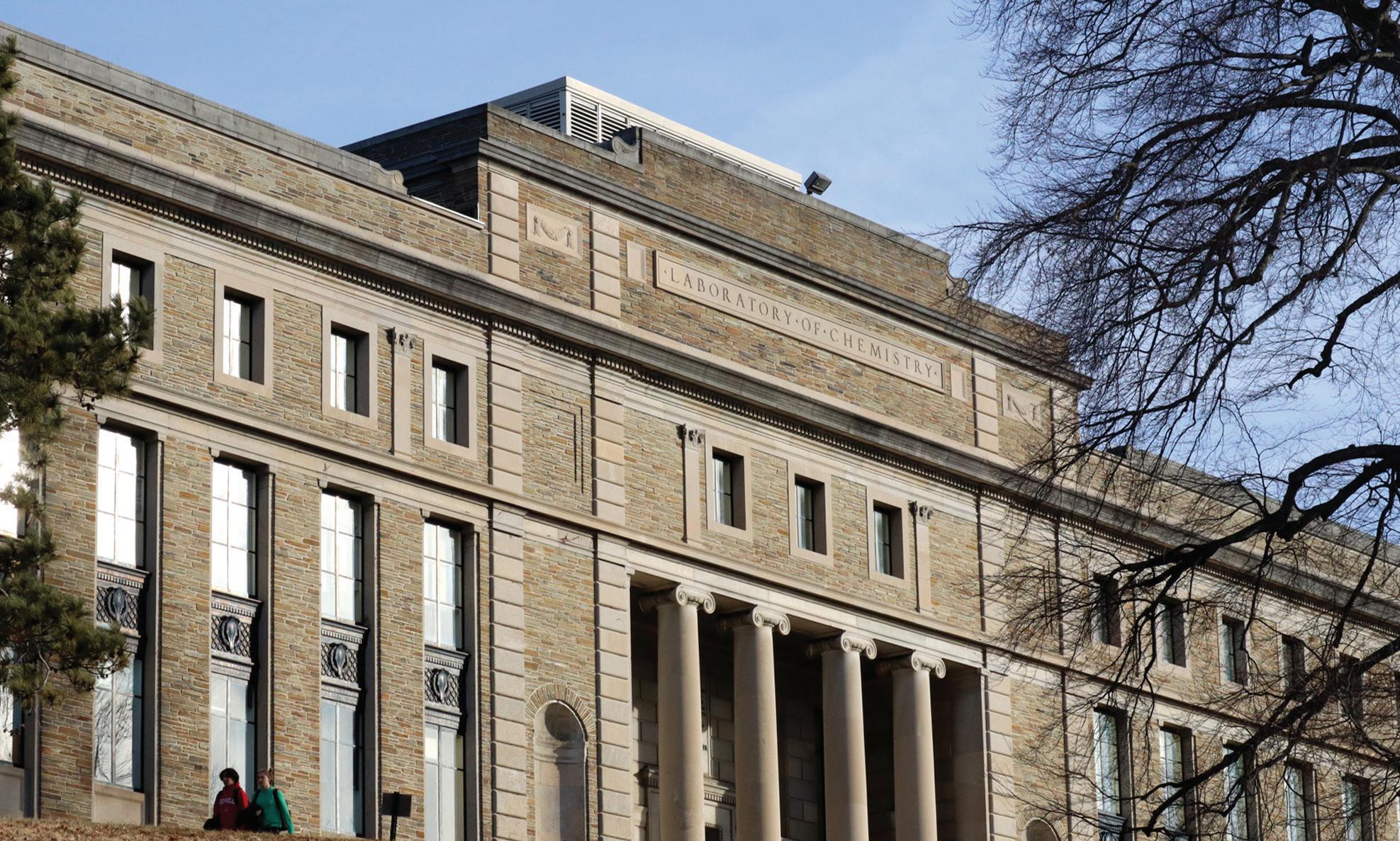
training workshops to promote best practices in reproducible research.
The replication efforts will be led by Florio Arguillas, a research associate at CCSS, who will also train students to assist with data validation and analysis, helping prepare the next generation of scientists to uphold rigorous research standards.
AR ² will further benefit from the resources of the Data Coordinating Center at Weill Cornell Medicine, which sup -
ports large-scale clinical trials and real-world data studies across academia, government and industry.
The three-year project is expected to lay the groundwork for long-term improvements in scientific transparency and reproducibility. The cross-campus collaboration, researchers say, represents a model for future initiatives that seek to build public confidence in scientific discovery.
Marissa Gaut can be reached at mgaut@cornellsun.com.

By Jared Miller
Jared Miller is a sophomore in the College of Agriculture and Life Sciences. He can be reached at jmm792@cornell.edu.
This is a message to the Class of 2028, a message to all of you new sophomores doubling as ex-freshmen.
As the elasticity of the freshman-year friend group inevitably presents itself this semester, there will be upsetting moments of our little squad drifting away. As everyone relocates to their respective apartments, West Campus buildings and Greek Life houses, nobody will be more crushed than I am.
Although you’ve seen me a million times, you probably never noticed I was there. Or maybe you never cared to look.
Although we hung out almost every day last year, you probably don’t even know who I am.
I am a dorm hallway. Or maybe I’m a common room. Possibly even your friend’s room, a quad or any other nook, cranny and crevice that you’ve spent your precious formative time in.
The legacy of this room will be impactful but often forgotten. Cycles of freshmen enter and exit through my creaky and paint-chipped doors, year after year. Each new group that blesses me with their presence feels unique, but the experiences they share are eerily familiar. Their stories echo those who came before. As the energy of the friend groups shifts, the only aspects truly changing are the faces.
Although I already miss those of you who used to spend your late nights and early mornings with me, I am excited to embrace the next generation of freshmen who are generous enough to keep me company. I’m already enjoying watching the slow, but gradual, process of a group of strangers entering my space and then leaving as a family.
Although they may already notice all the little quirks and details that make this room special, I cannot confidently say that they will fully grasp and appreciate the origins of all the remnants of good times. You’ll never know the story behind the rubber chicken stuck in the light fixture, the word ‘gullible’ written on the ceiling, the broken fan, the stain on the love seat, the pumpkin bits stuck in the baseboards or why there are scratches in the carpet that suspiciously resemble the legs of the couch from the floor below.
The people who inherit this dorm common space in every year to come will never know the amazing memories and formative experiences that occurred in this room just a few short
months prior their arrival. The legacy of a common space is something that is not talked about nearly as much as it should be. The libraries, classrooms and dining halls get constant attention for how they have transformed over the years and how cycles of Cornellians have stepped in and out of the doors to those buildings. But me, the one constant in all of your freshman years, the place you dared to call a home, I don’t feel that I get the credit or recognition that I deserve. Let’s be honest, nobody remembers anything that happens in a library during study hours; what people remember is what happened in Mary Donlon hall at 3 a.m.
They say that when you die, nobody wishes they had spent more time at the office. I believe the same is true for our freshman year experiences. The concept of a common space perfectly encapsulates the idea that there is truly no time in our lives quite like the collegiate one. When else does everyone you know live three doors down from you and spend all their free time sitting and doing nothing and everything with you?
Although the Class of 2029 will never meet the people who inhabited this place before them, I hope they feel
“Each new group that blesses me with their presence feels unique”
Jared Miller ’28
the presence of joy that was left behind.
And to the Class of 2028, I am so grateful that I was able to gift you with the experiences and memories that only come with a freshman-year friend group. But I do ask for one thing in return. Please keep the memories going. Don’t let the friend group fade. Although all of you are no longer living three doors down from each other, and it will take some effort, the benefits of maintaining this structure vastly outweigh the inconvenience. The memories I facilitated are not limited to the context of the common space; they can live on. So please, I ask that you keep the group chat active and the friend group alive and kicking. If not for your sake, then for mine. Sincerely, the world’s most grateful fly on the wall.



By Martha Dolan
Martha Dolan is a sophomore in the College of Agriculture and Life Sciences. She can be reached at mmd289@cornell.edu.
Picture this: you are sitting in a large lecture hall, staring out into a sea of people. At first glance, it looks and sounds exactly like you would expect — laptops open, notebooks out and the professor’s voice drifting through the room. However, instead of the lecture slides and notes open on students’ computers, you notice the glow of colorful grids and letters scattered throughout the room. Some people look intensely concentrated on their personal device, while others compare their screens to their neighbors’. It’s not the lecture content that has captured the attention of the class, it’s a mix of the Wordle, Connections and Mini Crossword puzzles — the New York Times games that have turned into daily in-lecture activities for many students. The professor’s presentation seems to have become background noise, and the focus of the class period alternatively lies in finishing the puzzles before the lecture ends.
I will admit that I have fallen victim to the NYT Games obsession. Sometimes, the quick and engaging word games are just what I need to get through a 75-minute lecture. It has become a habit, almost like second nature, for me to open my phone and scroll to the NYT Games app. My friends and I frequently compete to see who can solve the Wordle in fewer guesses or work out the Connections the quickest. The games offer a distraction that can make dull lectures pass by more quickly. I know that I am not the only one who has been captivated by these games — a brief look around the room will prove that dozens of other students are doing the same thing.
For many students, the NYT Games have become a routine aspect of lecture time. One student on campus explained that they usually open the app, “in classes that are less engaging, ” adding that “boredom is the biggest factor that draws me to playing NYT Games in lecture.” They even admitted that, “I think it makes me absorb less from lectures because I use it as a way to distract my brain for a few minutes and reset.” These remarks reflect a broader pattern: when lectures begin to lose the attention of students, quick games like this can help to keep the mind stimulated and entertained. However, the mental stimulation it provides comes with a tradeoff — losing comprehension of key concepts during class.
On the surface, these puzzles seem like a productive distraction as opposed to social media apps or mindless games. They are intellectually stimulating, and they demand logic and focus. However, this does not change the fact that they pull attention away from the content being taught during lecture. The wide variety of games can easily consume a large portion of class time. Tuning a
professor out and instead turning your focus to games is almost effortless, especially in classes that allow laptops. These games are designed to be addictive — with a competitive edge involved and a new set of challenges each day.
Over the course of an entire lecture, these distractions can accumulate to a significant loss of focus and retention. Even brief lapses in attention can mean missing key points and examples that could be beneficial to learning. In addition to missing lecture concepts, our generation is developing an increasingly short attention span, in part due to these small bursts of rewarding content and instant gratification from apps such as the NYT Games. This pattern can make lectures feel monotonous and difficult to stay engaged.
Many students assume that it is possible to balance playing games while listening to a lecture. This raises the question of just how attainable it is to absorb material while slightly distracted. Maybe you only attend class to make sure you get your Poll Everywhere attendance point, or maybe you are interested in learning during the lecture. Either way, the presence of the NYT Games app tempts students to multitask, which can reduce comprehension. Research has shown that switching attention and multitasking can make it much more difficult to retain information.
While distracting in the classroom, the NYT Games can provide several cognitive benefits. Wordle, Connections, Pips and Spelling Bee are each a part of the collection of games that the New York Times offers. All of these games encourage critical thinking, problem solving and creativity. They also have the potential to help expand players’ vocabulary and mentally flexibility. These puzzles offer a great alternative to doom scrolling on social media. They can also help students reset and destress in a productive way. Using these as a deliberate study break, instead of during lectures, can allow students to reap the benefits of this cognitive reset, without missing information in lecture. Ultimately, the New York Times Games are not the problem; it’s the setting we choose to play them in. They can easily pull students’ attention away from learning during lectures, but outside of class, they can provide a much needed recharge. Solving these puzzles offers a greater intellectual benefit than scrolling social media ever will. Of course, it’s not the end of the world to sneak in a Wordle during class — everyone does it. The key is finding a balance between distraction and a productive reset: using the games as a study break can keep your mind sharp without sacrificing attentiveness when it matters most. Afterall, no puzzle is worth a failed prelim.

By ATTICUS JOHNSON Sun Senior Writer
Oct. 9 — Electricity bill costs could rise by as much as 39.4 percent in Ithaca, according to rate hikes proposed by the New York State Electric and Gas Corporation.
Residents from across upstate New York convened at the Ithaca Town Hall for NYSEG’s public comment hearing on Wednesday night. NYSEG consumers voiced opposition to the proposed hike of 39.4 percent for natural gas customers and 35 percent for electricity customers.
“The first thing I noticed when I got back to Ithaca was that I got less electricity than I did when I lived in sub-Saharan Africa.”
Aubryn Sidle
Throughout the hearing, not one speaker expressed support for the hikes.
As a distributor of electricity and gas, NYSEG is responsible for transmission lines, customer service and billing. The price of electricity and gas itself comes from more than 50 lesser-known suppliers that customers can choose from.
A consistent complaint with NYSEG revolves around its customer service. Now, the corporation plans on axing a customer service center in Northeast Ithaca.
Sebastian Nicholas Desystemizer, owner of Old Steel Bicycle Repair and Recyclery in downtown Ithaca, said that NYSEG is trying to “make sure there’s a firewall between the rate-raisers and us,” and that he thought the money might go to data centers.
TeraWulf, an artificial intelligence data center developer, recently secured a long-term lease adjacent to Cayuga Lake.
When there were downed power lines with live wires, Newfield resident Matonna Stallmann said NYSEG took many hours and endangered the lives of firefighters when the live wires broke out into a fire, burning two trees. There were “no apologies and no explanation” from NYSEG — even after a similar situation occurred three times, according to Stallmann.
“The first thing I noticed when I got back to Ithaca was that I got less electricity than I did when I lived in sub-Saharan Africa,” Aubryn Sidle, a resident of Ulysses, said. She added that her house is equipped with energy-efficient technology, but she still sees her bill increase every year.
Consumers also mentioned delays in NYSEG responses, the slow progress in a renewable grid, fraudulent electrical bills and continuous rate increases. They also expressed opposition to NYSEG’s parent company, Spanish corporation Iberdrola.
In an interview with The Sun, Congressman Josh Riley (D-N.Y.) — who spoke at the hearing — said that what NYSEG is attempting to do “should be criminal,” and that NYSEG is taking money out of New York and sending it to Spanish executives “swimming in obscene amounts of profit.”
“Especially when the power goes out when the wind blows,” Riley said.
The Southern Tier congressman added that he introduced the Keep the Lights On Act, which would ban foreign governments and corporations like Iberdrola from owning American utility companies like NYSEG.
“Especially when the power goes out when the wind blows.”
Rep. Josh Riley (D-N.Y.)
State Assemblywoman Anna Kelles (D-N.Y.) also attended the
hearing and asked NYSEG to “fix [its] problems first” before asking for any further funds.
“Where is the data collection?” she said. “Where are the efforts to minimize the costs of losses?”
The corporation’s reasoning behind the statewide utility company’s proposed price hikes comes from demands to increase construction on large, renewable capital projects to address aging infrastructure and increase capacity.
Riley said that on the day that NYSEG proposed a $464.4 million statewide rate hike, Iberdrola sent $450 million to its shareholders overseas.
The Spanish utilities giant sent out a total of $1.17 billion in dividends to their shareholders in 2024, records show.
Gov. Kathy Hochul (D-N.Y.) also has publicly opposed the hikes, urging the Department of Public Service to find other ways to raise funds without raising rates.
NYSEG is proposing the hikes to the New York State Public Service Commission, which must approve the rate increases in an Oct. 16 meeting. If approved, the hikes will go into effect in early 2026.
Atticus Johnson can be reached at ajohnson@cornellsun.com.
By Shubha Gautam
Sun Senior Writer
Oct. 8 — A plan for Tompkins County and the city of Ithaca to build a joint homelessness service center and Code Blue shelter at the former Burger King on Elmira Road fell apart just weeks after it was first announced in early August. While the county is set to open a Code Blue shelter on 227 Cherry St. next month, the Elmira Road site is planned to be demolished on Saturday due to unsafe living conditions.
According to Dan Klein, chair of the Tompkins County legislature, the idea of a joint homelessness facility was first discussed by the two bodies in the spring of this year. This facility, whose operations were outlined by Ithaca’s Advisory Committee on Encampment Response Policy, organized to address unsheltered homelessness, would act as a “navigation hub” by day, providing bathrooms, showers and access to rele-
vant services to unhoused Ithacans.
By night, the site would be a Code Blue shelter, providing shelter for unhoused residents whenever the temperature drops to 32 degrees or below from 4 p.m. to 8 a.m. daily.
The city approved a sub-lease of the site in early August. But once the county was able to inspect the building and evaluate renovations, Klein said the expected costs rose. He said that while the building itself was assessed at $200,000, adding heating, plumbing and other necessary amenities would cost an additional $750,000. Additionally, during times of maximum occupancy, residents would have to sleep on bunk beds due to the small size of the site.
According to Klein, considering that the county only planned to rent the site, spending that much in taxpayer money for a facility that would likely not be ready until next year “didn’t make sense for us anymore.”
“As we got further into this project, we started

discovering more and more problems with the building itself,” Klein said. “And based on the extent of the problems and when we could get somebody to work on these issues, we didn’t believe that we could get the building ready before January. That’s just too far into this season.”
Klein said the city code enforcement officer later deemed the location “unfit for human occupancy” in a Sept. 12 violation notice. Duanne Miller, executive facilities manager at Maguire Cars, which owns the plot, said the company applied for a demolition permit. The permit has not been granted by the city yet, however, and the company plans to develop the property in the future.
In a city statement, Mayor Robert Cantelmo expressed disappointment with the county’s decision to delay the partnership.
“Irrespective of the logistical considerations at hand, this decision represents a walking back of the commitment [to not make a decision about the temporary shelter’s location without community input],” Cantelmo said. “As we always have, the City of Ithaca will contribute when called upon by the County and our partner agencies. But we also expect those partners to make good faith efforts to conduct their necessary due diligence and work together toward common solutions.”
Dominick Recckio, deputy city manager and chair of the advisory committee, said the Elmira Road location was integral to the navigation hub’s operations. The committee deemed the site the only viable option for setting up permanent bathroom and shower facilities near Southwest Park, a 28-acre parcel of city land where the city currently allows encampments.
A report from the committee adopted by the Common Council in May said improvements to the land may require the city to “obtain a permit to operate a campground per State regulations,”
which would include on-site water supply and sewage system.
The Cherry Street location, however, is too far from Southwest Park to be in compliance with campground regulations, according to Recckio. Additionally, he said traveling from the encampment area to the future Code Blue shelter would involve traversing “a densely wooded area railroad tracks.”
“From my perspective, [the Cherry Street location] doesn’t fit the city’s needs of what an operating navigation hub under our context would need to be,” Recckio said. “Knowing that it’s not at the desired location, I think [operating a navigation hub there would be] less advantageous for us to be a part of.”
The county is focusing on renovating the Cherry Street location, the current home to Found in Ithaca, to be this winter’s Code Blue shelter. Found in Ithaca will reopen in the former Morse Chain building as part of Southworks, a new commercial and residential neighborhood in town. Klein said the estimated costs of renovation are $100,000 and will take around two weeks to complete.
A non-profit organization is likely going to run the shelter and is proposing a daytime facility to be run on the site, according to Klein. Since this would mean no additional costs by the city to operate their navigation hub on Cherry Street, the county is inviting Ithaca to open their hub at the location.
“What the Cherry Street location doesn’t do for [the city] is it doesn’t provide the location for the bathrooms for the campground that they’re looking for,” Klein said. “[But the city also wanted] to provide services, and so we are inviting them into our space.”
Shubha Gautam can be reached at sgautam@cornellsun.com.



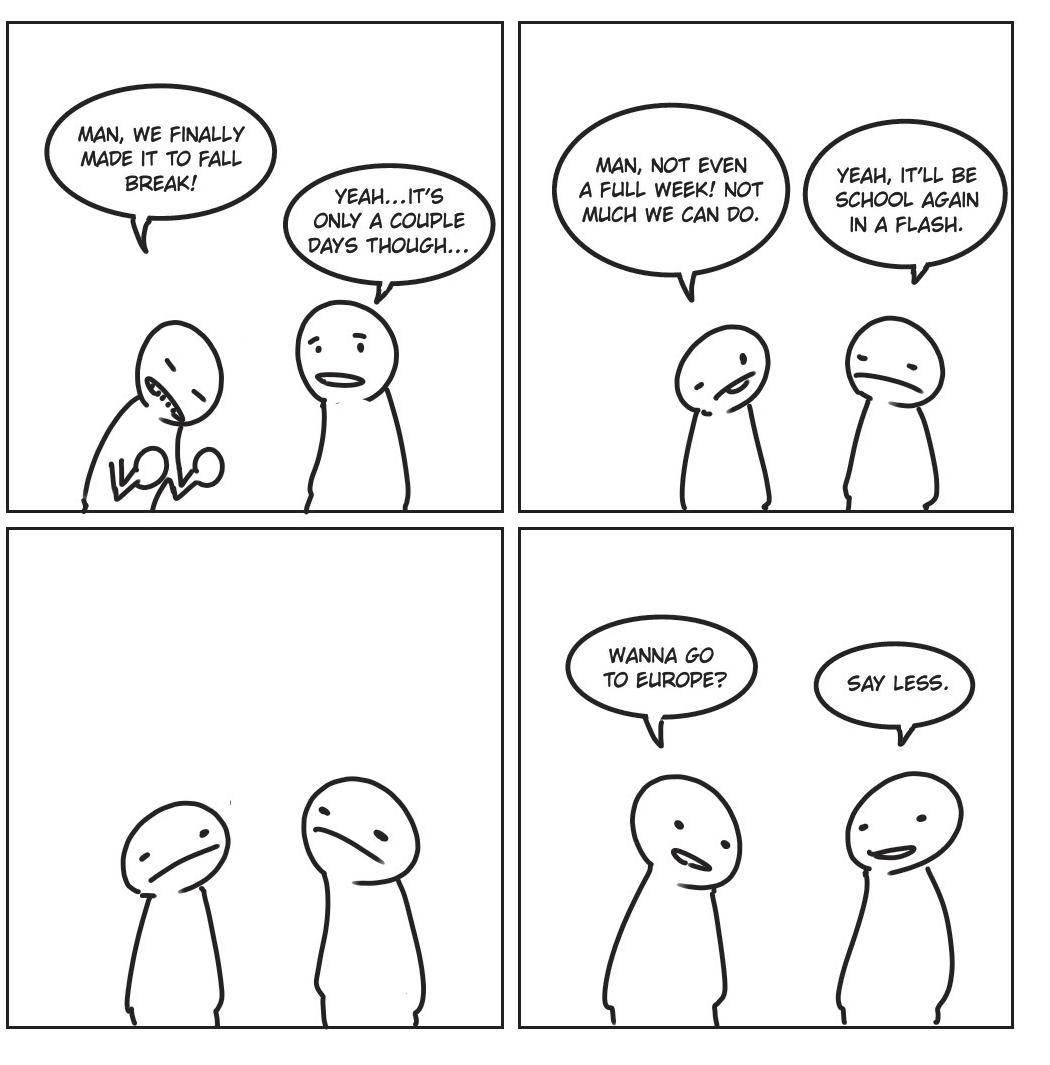

By DALTON MULLINS Sun Staff Writer
Oct. 8 — The Friends of the Tompkins County Public Library is hosting its biannual book sale of over 250,000 books this October. The booksale, which has become one of the top five largest book sales in the country, carries books, games, records, comics and more.
The sale has served as a fundraiser since 1946. Money raised through the sale will be donated to the Tompkins County Library, other local libraries and will be used for grants. It will officially kick off Oct. 11, lasting until Oct. 28 and will be open on select days until its conclusion.
“You never know what you’re going to find because they have books on everything from sports to travel to music.”
Miguel Barrera ’24
Chris Hallam, coordinator of the Friends of the Tompkins County Public Library book sale, explained that the book sale is unique for its massive scale. In total, Hallam said that the sale generates over half a million dollars per year through the sale. The booksale happens twice a year, and both the Fall and Spring book sales earn nearly equal amounts of money. The last two sales had “a difference of like seven dollars,” according to Hallam.
All of the money raised from the sale is donated to the Tompkins County
Public Library and other surrounding libraries in the Finger Lakes region. Hallam also said that additional money raised is donated in the form of three grants: a library grant, an education grant and a community grant.
“A library grant is for the library if they need money for a special collection,” Hallam said. “We have an education grant that goes to students who are studying library science … [and] the community grant, which is for other community organizations that do things with books.”
The sale also features the “Collectors’ Corner,” which only admits a certain number of browsers at a time. Bookbuyers must wait for their name to be called to enter a small room of rare and valuable items.
“In the Collectors’ corner, we also sell unusual things like a hemispheric gauge, which, if you line it all up with the stars, can tell you the tides,” Hallam said. “It’s very strange some of those things we get.”
For Miguel Barrera ’24, the sale is exciting because of the “mystery” of items offered.
“You never know what you’re going to find because they have books on everything from sports to travel to music,” Barrera said. “It’s really kind of a mystery that I think is fun to go check out and see what’s there this year.”
Although the sale only takes place twice a year, Hallam said that volunteers work a combined 14,000 hours for each sale. Once volunteers receive donations from the community, they must sort all the books into different categories and place them on the
shelves. After the sale is concluded, volunteers then facilitate the donation of leftover books to local public and school libraries.
Diana Mena ’26 volunteered for the sale during her freshman year. Her shift was about six hours, where she worked on reorganizing the books and assisting patrons in finding what they needed. The experience was uplifting for Mena as she saw the sale’s impact on the community.
“I really liked what they stood for, cause it was very much great, wholesome, loving vibes and community vibes as well,” Mena said. “It made a lot of people happy and they made me happy to see those people happy.”
On Oct. 22, the sale will have a student night, where the books will be ¢10 to $1. Hallam also said that any-
one is welcome to join the book sale by volunteering.
“You just can come in with a student ID and shop, and the prices go down after the first weekend — they go down every day,” Hallam said. “And we just have a good time here if anybody wants to come and volunteer.”
“I really liked what they stood for, cause it was very much great, wholesome, loving vibes and community vibes as well.”
Diana Mena ’26

By AUSTIN CURTIS Sun Sports Contributor
Oct. 15 — Fearless. That’s the word senior goalkeeper Natalie Medugno used to describe the women’s soccer team’s defense — and it might just be the best word that describes her, too.
In an announcement on Sept. 29, Medugno was named Ivy League Defensive Player of the Week, marking the first time in her four-year collegiate career that she has received the honor.
For Medugno, the recognition was both thrilling and motivating — not just for herself, but for the team as a whole.
“It was exciting. I think it was exciting for my team,” Medugno said. “[This accolade] was our first one of the year, so [it was] just kind of motivating for everyone.”
Medugno studies human development in the College of Human Ecology and has been a mainstay for the Red since arriving in Ithaca. The Oceanside, New York, native began playing soccer at the age of four and developed her game with Long Island Soccer Club, part of the U.S. Soccer Development Academy.
At the time, DA athletes were not permitted to play high school sports, but a later transition to the Girls Academy League allowed her to represent her high school again during her senior year — a balance she found both challenging and rewarding.
Originally a forward, Medugno transitioned to goalkeeper in seventh grade, a switch that proved to be pivotal for her career. She committed to Cornell during her junior year of high school and has continued to grow as both a player and a leader through her three completed seasons, and now into her fourth.
“I think representing Cornell is such an honor, not only for soccer, but just to be a part of the Ivy League,” Medugno said. “Just representing at a division level, a lot of people dream for this.”
Playing Defense in Division I
Representing Cornell at the Division I level, Medugno said, remains a privilege she carries with pride.
And that pride translates directly into the way she plays. Individually, Medugno said her defensive instincts and field awareness have become defining strengths.
“For me specifically, I think I have a good vision of the field, and that doesn’t only come from being in the back [of the field] and seeing everyone, but I think I see certain moments and counterattack opportunities that can catch the opposing offense on their heels.”
That clarity on the pitch has grown thanks to the experienced unit in front of her. Medugno praised senior teammates Izzy Scott ’26 and Gaby Gonzalez ’26 for their dominance on the back line.
“We have two amazing center backs, Gaby and Izzy, who have been the best players for not only our team, but I do think in the Ivy League,” she noted. “They are fearless, and I think that is the definition of our defensive unit. Just fearless … we will win with our grit.”
Her teammates’ excitement over Medugno’s Ivy League recognition reflected that same team-first culture.
“Nat[alie] is a hardworking, driven, competitive, and resilient individual,” Scott wrote in a text to The Sun. “She is the glue to our team dynamic and has made such an impact not only on the field but off the field as well. Her commitment to what she cares about, whether that’s school, soccer, or people, is why Nat is one of a kind.”
Her goalkeeper coach, Danielle Reid-Espinal, said Medugno’s growth over four years has been vital to Cornell’s success.
“Each year she matured as both a player and a person and in her final season we are fortunate to have her at her best yet,” Reid-Espinal wrote in an email to The Sun. “She has been focused and deliberate with her training in preparation for this season and I am confident she will see continued success.”
To continue reading, please visit www.cornellsun.com.
Austin
can be reached at arc352@cornell.edu.


By KITTY ZHANG Sun Science Staff Writer
Oct. 15 — For most kids, reading and dancing might seem like two completely different worlds, one quiet and focused, the other full of rhythm and movement. But at Ballet & Books, the two come together to create something new: a space where stories move, words take shape and confidence grows.
Founded in 2017 by Talia Bailes ’20, a lifelong dancer and global and public health sciences major at Cornell, Ballet & Books began in Ithaca with a simple idea — combining reading and ballet to support early childhood literacy and self-expression.
“We want to make sure that every child, regardless of background, gets the chance to dance, to perform and to wear the tutu and leotard.”
Leyla Rivera ’27
Eight years later, the program has grown into a national nonprofit with 13 chapters across the country. To many families, the program is much more than a weekend activity. It is a space where kids can express emotions, build confidence and form meaningful bonds with mentors who support them both in the studio and in life.
“We want to make sure that every child, regardless of background, gets the chance to dance, to perform and to wear the tutu and leotard,” said Leyla Rivera ’27, co-president of the Ithaca chapter. “But more importantly, they learn how to turn what they’re feeling and thinking into a story and put their emotions out into the world through dance.”
“We’ll read stories about rain and then do movements that shows what rain feels like ... it’s amazing to see how they remember both the word and its meaning through movement.”
Libby Elman ’26
Each session lasts about an hour and a half, and the children, grouped as Seeds (ages three to five) and Sprouts (six to nine), rotate between 45 minutes of literacy and dance, led by their college volunteer mentors. The reading sessions follow a national curriculum developed by educators, while the dance portion is guided by whatever captures the kids’ curiosity, their favorite music that week or the “word of the week” from the reading session.
“Let’s say the word of the week is rain,” explained Libby Elman ’26, v.p. of marketing and a ballet teaching assistant for the Ithaca chapter. “We’ll read stories about rain and then do movements that show what rain feels like. The next week, we’ll ask, ‘Who remembers the move for rain?’ And it’s amazing to see how they remember both the word and its meaning through movement.”
While the reading activities build vocabulary and comprehension, the
dance allows children to embody what they learn by translating abstract ideas into physical expression.
“It’s the ability to process meaning, to remember words and what they mean, and then put those words into making new meaning,” Elman said. “It really is like a psychological development.”
“This is also a kind of literary expression, the ability to turn what they’re feeling and what they’re thinking into a story.”
Libby Elman ’26
One especially meaningful part of Ballet & Books happens when children use movement to express emotions that might otherwise go unspoken.
“If they’re really frustrated one day, maybe during freestyle dance, they’re jumping around a lot or moving more harshly. If they’re happy, they’ll be twirling and smiling, moving with more lightness and fluidity,” Elman said. “This is also a kind of literary expression, the ability to turn what they’re feeling and what they’re thinking into a story, and communicating it and putting their feelings out into the world.”
Beyond literacy and movement, what makes the program special are the relationships that form between children and their mentors. Each child is paired with a college volunteer for the duration of their time in the program, often building a connection that lasts for years, sometimes even after the mentors graduate.
“For a lot of our kids, their parents are really busy,” Rivera said. “So having someone who’s there just for them, someone who listens, believes in them and cares, gives them a real sense of security.”
At the end of each semester, the children take the stage for a small showcase for family, friends and the community. The program also removes financial barriers: all leotards, shoes and costumes are provided at no cost, ensuring that every child can experience the joy of performing.
“The little kids are so excited to see their parents bring them flowers after the show,” Rivera shared. “You can tell how proud everyone is. It’s such a special moment.”
Across the country, there are countless kids who love to dance or need extra help with reading but don’t always have access to opportunities that make both possible. That’s what makes programs like Ballet & Books special. They give them that support, offering a place for children to grow, to express themselves, and to feel truly seen.
“You can tell how proud everyone is. It’s such a special moment.”
Leyla Rivera ’27
“I think it’s so wonderful that I can leave memories with kids that will last forever,” said Elman. “We want every single child to feel included, welcome, and confident. That’s what matters most.”
Kitty Zhang can be reached at az429@ cornell.edu.
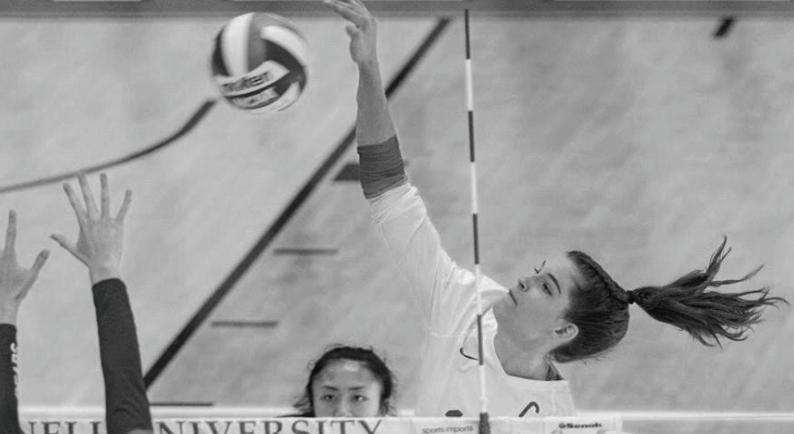
By MERIEM FARAH Sun Sports Contributor
Oct. 9 — What began as a simple after-school activity in fifth grade quickly became something more: a source of motivation, friendship, and purpose that would carry her from her hometown of Houston, Texas, all the way to Ithaca, New York. Studying computer science in College of Engineering, senior captain Eliza Konvicka recently surpassed an impressive milestone: 1,000 career kills, a testament to her years of hard work, passion and leadership.
Growing up near Rice University, Konvicka often found herself courtside, watching the women’s volleyball team with wide eyes and restless excitement. The intensity of the games, the quick dives, powerful serves and cheers pulled her in completely.
“I went to every single volleyball game and idolized those girls,” Konvicka said. “I wanted to go play in college, so I started as soon as I could.”
From fifth-grade camps to club tournaments in seventh grade, Konvicka immersed herself in the game. By the time she arrived at Cornell, “I just hoped I’d make the travel roster.” Now, as a senior captain, right side outside hitter and a 1,000-kill milestone hitter, she’s far surpassed that early ambition.
The 1,000 Kills Moment
Konvicka reached 1,000 kills earlier this season, during Cornell’s (8-5, 3-0 Ivy League) matchup against Buffalo on Sept. 14, an achievement she didn’t even know she was on track for until an old athletic trainer texted her congratulations.
“I never expected it,” Konvicka said. “It was never something I assumed I’d get or take for granted.”
“I would say that playing with a teammate as strong and consistent as Konvicka allows everyone else on the team to feel more confident,” wrote junior middle blocker Ava Bogan in an email sent to The Sun. “Her style of play is both incredibly strong and calculated at the same time, it’s no wonder she’s a part of the 1,000 club.”
Konvicka remains focused on what’s ahead.
“You can be happy about it, but then it’s on to the next thing,” Konvicka said. “It’s all about moving forward and keeping your eye on the prize.”
For younger players, she hopes her milestone sends a message.
“It shows the underclassmen that hard work throughout your four years is important,” Konvicka said. “You can get to that point.”
That determination has defined her not just as a player, but as a leader.
“Eliza is one of the most motivated teammates I have ever played with,”
in an email to The Sun. “Her drive to succeed — for the team to succeed — pushes everyone around her. She drives everyone to be better, out of genuine care and commitment to the team.”
Konvicka has served as team captain for two consecutive seasons, first as a junior alongside senior leaders and now as a senior co-captain with junior middle blocker Amrit Dhaliwal. Leadership, she explained, was a learning curve.
“It’s a vague title at first. You have to figure out what it really means,” Konvicka said. “I’m a very intense player and super competitive. At first I assumed that’s how everyone thought, but it was a learning process of, ‘How do you get your message across to different people?’”
Serving Student-Athlete
As a computer science major in the College of Engineering, Konvicka’s life has been a careful balancing act.
“If you’re really driven with athletics and academics, you don’t mind the sacrifices,” she said. “But you do have to be willing to fully commit to those two things.”
What truly sets Konvicka apart is her constant connection to the sport.
“Her dedication to the sport is beyond impressive,” Mallus wrote. “She gives so much to the team on and off the court, constantly thinking about what is best for us.”
Whether she’s at home in Texas or here in New York, volleyball is never far from her reach. Konvicka plays wherever she can on the beach, on grass, or in the gym, adapting to every surface and style.
“I think my biggest improvement has been going home,” Konvicka said. “I just play so much pickup … like beach volleyball, grass volleyball, … and at open gyms”
Each version of the game pushes her in different ways: beach volleyball strengthens her movement and control, while indoor competition hones her precision and timing. That steady rhythm of play, year after year, has shaped Konvicka into a versatile and confident player.
“I go home and I play with a bunch of different people and learn different things,” Konvicka said. “Then, I come back and I have these new skills I didn’t even know I learned until I do it at Cornell.”
Even her top-spin serve, one of the few in the Ivy League, has a story.
To continue reading this article, please visit www.cornellsun.com.
Meriem Farah can be reached at mf862@ cornell.edu.
After nearly two decades on air, Dancing with the Stars remains one of the longest-running reality competition shows in television history. Its format — pairing celebrities with professional dancers in a glittering ballroom competition where fan voting determines the outcome — has captivated audiences since its debut in 2005. Yet, longevity and relevance in today’s entertainment landscape are not easy to sustain. By the mid-2010s, the series experienced a dip in ratings, losing momentum due to an increasingly digital and fragmented media environment along with a general loss in interest from its current viewers. So, how did the show rebrand itself and reconnect with a whole new audience?
The show’s revival can be attributed to its adaptation to digital platforms, the introduction of a younger generation of professional dancers and the integration of social media engagement. By expanding to more streaming platforms, DWTS not only expanded accessibility but also repositioned itself within Gen Z’s viewing habits. The new Season 34 premiere episode drew over 8 million viewers across ABC, Hulu and Disney+ after three days of airing — an 18 percent increase from last season — and generated 21 million fan votes, up 163 percent from the previous year’s debut. This resurgence reflects how DWTS has evolved into a multi-platform experience, where clips, highlights and behind-the-scenes footage circulate on TikTok and Instagram, reaching audiences who
might never have watched a full broadcast episode. This rebranding effort has also been visible through the rise of new pro dancers. While DWTS has always depended on the charisma and talent of its professional dancers, recent additions — such as Rylee Arnold and Ezra Sosa — have introduced the realm of social media into the show. Both are active social media personalities, cultivating fanbases beyond the show’s weekly episodes. Their online personas extend DWTS ’s reach, sharing an intimate look at rehearsals and outtakes. For younger audiences, this transparency resonates. Gen Z viewers value authenticity and originality; they want to see the behind the scenes and bonding moments between the celebrity and the pro dancer just as much as the performance. But while the younger pros like Arnold and Sosa have injected a newfound energy into the show, they must also be able to adapt to the show’s fast-paced nature and take on the role of mentor and teacher toward their celebrity partners.
Season 34 echoes this new generational bridge more evidently. The lineup includes a diverse group of contestants — ranging from Australian TV personality Robert Irwin to Olympic gymnast Jordan Chiles to TikTok influencer Alix Earle — reflecting the show’s conscious effort to attract a broader and younger demographic. For instance, week three’s theme was TikTok night, a theme that exemplifies DWTS’ s approach to stay relevant. Contestants danced to viral songs and trends: Alix Earle and partner Val Chmerosky’s danced a quickstep to the TikTok song “Pop Muzik,” while Robert Irwin and partner Whitney Carson danced
to “Million Dollar Baby” and Scott Hoying and partner Rylee Arnold brought K-Pop energy to “Like Jennie.” While the performances were lively and upbeat, the choreography felt secondary to the dances, which seemed choreographed less for the ballroom judges and more to entertain the audience — with an emphasis on energy rather than technical dance style.
So, with the ever-changing landscape of social media presence and reality television, there’s a fine line DWTS has to walk. In appealing to Gen Z, the show can’t lose sight of what had made it iconic for nearly two decades: the artistry, elegance and discipline of traditional ballroom dance. From the graceful waltzes to the precision of the foxtrot and the passion of the tango, these styles are the fundamental core of what the show was made for, and they are what separates it from becoming just another reality dance show. Yet, the reality remains that much of DWTS ’s new fanbase comes from Gen Z, and the show must evolve to stay commercially viable. Thus, striking the balance between tradition and innovation is critical. So although the introduction of upbeat, contemporary styles keep the show fresh and relevant, the heart of the competition must remain rooted in the ballroom. The challenge for DWTS moving forward is to continue evolving without losing its essence — to keep captivating new audiences while preserving the artistry of ballroom dancing that has kept viewers watching all these years.
Alex Chou is a junior in the College of Architecture, Art, and Planning. She can be reached at apc97@cornell.edu.
SYDNEY LEVINTON
At any given moment, odds are that I have a song stuck in my head. Sometimes, it’s just random — a song I find catchy or have been listening to around the clock that’s creeping into my brain during the few occasions that I’m not actually listening to it. But other times, I subconsciously create a soundtrack that reflects what is going on in my life. By this point in the semester, it’s practically a given that we’re all itching for fall break, and the moment Monday hit, there was only one song that popped into my head: “The Sweet Escape” by Gwen Stefani and Akon. Lyrically, it could afford to be more relevant to my current situation, but the title wholly encompasses my desire to blow this popsicle stand and take a break from the grind. “The Sweet Escape” has persisted in my mind ever since as a constant reminder that break is near, and what better way to celebrate than to review Stefani’s 2006 album by the same name?
The Sweet Escape begins with what is perhaps its most unexpected track, “Wind It Up.” The first seconds of the record are filled with Stefani yodeling a part of “The Lonely Goatherd” from The Sound of Music, one of Stefani’s favorite musicals. At first listen, it’s disconcerting and sounds more like a warped military march overlaid with the Mason Ramsey’s Walmart rendition of “Lovesick Blues” than anything else; that being said, I can appreciate the courageous effort to interweave Stefani’s distinct style with fragments of a classic musical. You can’t blame
a girl for trying. Next is the star of the show: the album’s title track. Akon opens with iconic “woo-hoos” and “yee-hoos” that lead into some of Stefani’s best vocals in her solo career (No Doubt’s “Don’t Speak” and “Just A Girl” hold special places in my heart and are in a different category altogether). Here, Stefani apologizes for a fight she had with her significant other and longs for the perfect relationship with no arguments. Although “The Sweet Escape” is immensely catchy and it’s easy to get swept up in the melody, a closer look at the lyrics makes it clear that this song is definitely not fluff; “I must apologize for acting stank and treating you this way / ‘Cause I’ve been acting like sour milk all on the floor / It’s your fault, you didn’t shut the refrigerator / Maybe that’s the reason I’ve been acting so cold,” she sings. In “Orange County Girl,” Stefani reminisces on life before fame. In terms of content, the song had the potential to be great, but it falls short sonically. The backing track sounds so discordant with her voice to the point where it’s almost jarring.
Back in 2006, Mark Pytlik reviewed The Sweet Escape for Pitchfork, where he argued that “With the exception of the spazzy, Akon-produced doowop track “The Sweet Escape” and the Keane-penned “Early Winter” — which proves that Stefani still has the ability to elevate an otherwise ordinary rock song to another level — everything else here has the vague whiff of tossed-off album fattener.” One thing is for certain: Pytlik couldn’t be more correct in labeling “Early Winter” an album standout on par with “The
Sweet Escape.” Written by Keane pianist Tim Rice-Oxley, this track connects the changing seasons to the end of a relationship. Both Stefani’s vocals and the instrumentals manage to hit the ideal but elusive combination of upbeat and melancholy. “Now That You Got It” is a turn to hip-hop that sees Stefani warning her boy to treat her right against a severe staccato and siren sounds. While “The Sweet Escape” and “Early Winter” are the highlights of this record, a case can definitely be made for the synth-infused “4 In The Morning,” where Stefani demonstrates just how much she wants to make her teetering relationship work. Stefani experiments with her vocals on “4 In The Morning” in a way that evokes her best work with No Doubt. Pharrell produced many of the songs on The Sweet Escape, but we actually hear him a bit on “Yummy.” It’s a lyric-focused track with a simplistic backing track that does the entire song a disservice. I don’t believe anyone but Gwen Stefani could pull off this kind of song — she’s just the right amount of playful and sassy — and it’s her execution that prevents this song from being a complete flop. “Fluorescent” basically screams “Gwen Stefani” in its moody sound but disappoints with its lyrics. I love a good double meaning and Stefani serves it with “Breakin’ Up,” albeit a tad repetitive. “Don’t Get It Twisted” involves some reggae influences and sees Stefani working through some complicated thoughts regarding her unexpected pregnancy. “U Started It” is a fun, nostalgic addition to the album. It may be simple in comparison to the rest of the album,
but The Sweet Escape needed something smoother and unostentatious, and The Neptunes delivered with the production on this song. The record closes with “Wonderful Life,” which includes contributions on the guitar from Depeche Mode’s Martin Gore. Stefani dedicated this song to her late high school boyfriend who really admired Depeche Mode: “...the amazing thing about that song was that that guy was the first person to turn me on to Depeche Mode and the Cure. So I got one of his heroes to play on that song.”
Despite the album’s dips, there’s a lot to love about The Sweet Escape Nevertheless, no escape is sweeter to me than the imminent one from this campus. See you later, Cornell!
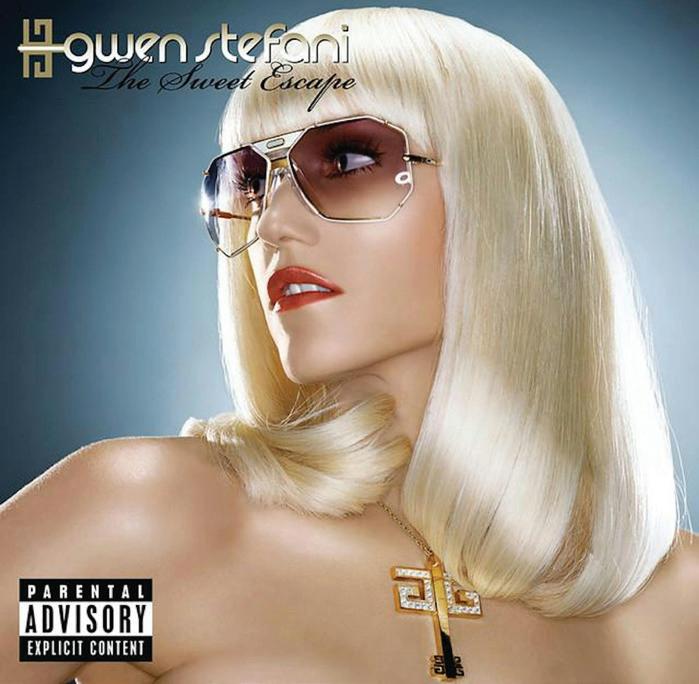
By EMMA ROBINSON Arts & Culture Writer
Sometimes a story is so entertaining that just reading it is not enough. When I find out a recent read has been turned into a movie, I cannot help but get excited. However, book-to-movie adaptations do not always work. Some miss the mark: ignoring important plot points, casting characters poorly or changing too much about the book that the movie feels like a different story entirely. This is a list of some of my favorite book-tomovie adaptations that not only do the books justice, but also enhance the magic surrounding the tale.
Pride and Prejudice (2005)
Both my favorite book and movie of all time, this adaptation has no notes from me. I grew up watching this movie every year and while it took until the age of around 10 for me to understand the flowery language, I have a deep love for this film. The movie follows Elizabeth Bennet (Keira Knightley), one of five sisters as she navigates the world of young adulthood in early-19th-century England. For those of you unfamiliar with the general plot, Elizabeth or Lizzy is introduced to a rich man named Mr. Darcy, whom she initially dislikes. However, over time, she begins to see his true character and the two fall in love. This movie captures the desperate love of the original novel. Much of this is due to the chemistry between the two main actors and Knightley’s own excellent and accurate characterisation of Lizzy. With whimsical scenes of English countryside (my favorite being the seaside cliff scene), a strong and bookish female protagonist and a man who knows how to yearn, this movie hits all the marks.
The Hobbit
Although I read The Hobbit many years ago and loved it, I did not watch the movies based on the book until
this past month. Similar to what I remember about the novel, the movies are chock-full of random side quests and fantastical characters that add intrigue and amusement to the larger plot. While I will say watching these three movies is quite the undertaking as they are each roughly three hours, I still found myself engaged, which is saying a lot as I often grow bored of movies about half way through. The depictions of elves, dwarves, orcs and other magical creatures was greatly enhanced by the more modern special effects in these three movies compared to The Lord of the Rings movies. These movies bring the fanciful scenes and characters of the books to life and enhance the fantasy of the book without straying from the original story.
Harry Potter
Likely one of the most popular book-to-movie adaptations of all time, I had to mention the Harry Potter movies in this article. My personal favorite of the franchise is likely the fourth movie Harry Potter and the Goblet of Fire, as we not only get all the magical elements of Hogwarts but also an introduction to other schools for wizards and witches. Similar to the books, I grew so attached to the characters and thought each one was casted excellently. Emma Watson is just the perfect Hermione Granger. Hogwarts itself is also so beautiful and the setting has me yearning to get my acceptance letter. My one critique of these movies is that the later ones get very dark. This is also true of the books and objectively necessary for the plot, but I felt like the movies took a somewhat jolting turn around the sixth movie. Nevertheless, I have to rewatch these movies every year to get into the fall spirit.
Forrest Gump
One movie that you might not know was adapted from a book is the beloved Forrest Gump. Perfect for all ages, this movie truly feels like a novel in the manner that we
get to experience all the different eras of Forrest Gump with him. Tom Hanks does an excellent job at portraying Gump as an imperfect but at his core good character who allows life to take him wherever it may lead. My personal favorite aspect of his movie is when Forrest enters the shrimping industry as he promised his friend Bubba during the war. I also love Forrest’s family home with the large front porch and expansive yard that just feels so serene. This is another long movie by my standards, but I again found myself happily entertained and rooting for Gump throughout its entirety.
Last but certainly not least on this list are the four Hunger Games movies. Unless you have been living under a rock, you have seen at least one or two of these films. They do an excellent job at depicting a dystopian world in a very realistic way while also portraying the strong interpersonal relationships seen in the books. Jennifer Lawrence as Katniss Everdeen is one of my favorite castings of all time as she is able to show the full range of complex emotions anyone in Katniss’s situation might feel. The arenas themselves are also beautifully and savagely depicted. The new prologue movies Ballad of Songbirds and Snakes (2023) and Sunrise on the Reaping (releasing November 2026) dive into the backstory of characters from the original trilogy. This is one movie series that I have to binge watch as the action just does not stop.
Hopefully this article reminded you of some favorites that you can rewatch (or even reread) in the coming cooler months. The nostalgia certainly hits hard for me whenever I start any of these movies.
Are You Still Watching? is a column spotlighting what the Cornell community has been streaming. It runs every Wednesday.
Emma Robinson is a junior in the College of Arts and Sciences. She can be reached at elg229@cornell.edu.
By JANE LOCKE Arts & Culture Writer
Releasing a sequel to a movie 15 years after the most recent installment generally bodes for disaster. However, in the case of Disney’s newest release , Tron: Ares , the gap might have made the film better. Disney’s first journey into the Tron universe was in 1982, an early date for a movie that delves into the digital realm. The movie was one of the first films to extensively incorporate computer-generated graphics into the scenes; one 15-minute shot was completely made by a computer. The tradition of the Tron universe being a visually stunning light-up world was born, continuing in 2010 with Disney’s Tron: Legacy . With a budget of $170 million, it grossed $400 million dollars and became a cult classic just like its predecessor. While Tron: Ares might never become as iconic as the two Tron movies that came before, it still is worth driving out to the theaters to watch.
Tron: Ares follows the title security program, portrayed by Jared Leto. Constrained to the digital world called the Grid, Ares (and all such computer programs) can only enter reality for 29 minutes before they disintegrate back into the Grid. Julian Dillinger (Evan Peters) is the head of the tech company which owns the Ares program, racing against rival tech CEO Eve Kim (Greta Lee) to find the long-lost permanence code. This code, created by Kevin Flynn (Jeff Bridges), would allow for computer-generated organic material such as Ares to remain indefinitely in reality. Julian Dillinger hopes to use this code for villainy, while Eve Kim hopes to solve global issues. Ares simply wants to live.
The story of this movie was much better than I had expected. The period of time that has lapsed since Tron: Legacy actually aided the movie in
branching off and creating a new plotline, instead of being stuck trying to live up to plot expectations of the first movie. Tron: Ares pursues its own goals and characters and doesn’t seem hindered by nostalgia for the first installment. Audiences could easily walk into the theater without ever having seen Tron: Legacy and still enjoy the original story of the sequel. This doesn’t mean that the movie disregards the two movies that precede it; in fact, an entire subplot is dedicated to Ares traveling into the 1980s video game to search for the permanence code. The movie healthily balances respect for the source material with novel additions to the Tron universe.
A Tron movie would be nothing without groovy electronic music, light-up costumes and exhilarating light cycle races — futuristic motorcycles that create trails of destructive light behind them. Thankfully, Tron: Ares provides all of these. It’s missing Daft Punk’s beats, but Tron: Ares compensates with Nine Inch Nails laying down perfectly fitting head-bangers. The soundtrack is definitely one of the best parts of the movie. The costumes are only slightly modified from the tradition of Tron: Legacy and are therefore eye-catching, making you want to grab a disc and pretend to be a battle-ready program. Finally, a Tron movie needs action, which Tron: Ares provides readily. Whether it’s programs from different companies tossing discs, a race across water against deadly drones or a light cycle street battle, action is never far from the protagonists of this movie.
However, it was by no means perfect. Jared Leto, after starring in the complete flop that was Disney’s Morbius , delivers his typical performance in a movie — nothing. Ironically, however, his acting capabilities mesh well with the character he has been given. Ares is written as an emotionless program interacting with the wide world around him, so though
Jared Leto will by no means be winning an Oscar, he does not detract from the movie. Unfortunately, nor does he add anything special to it.
The writing of Tron: Ares is occasionally aiming to be deeply philosophical, but more often producing such hilarious exchanges like Ares commenting, “I’m curious,” and being responded to with “I’m curious why you are curious.” Yet, this movie was never meant to be a masterpiece of cinema that makes you think harder. Expecting it to be so will only ever leave you dissatisfied. If you are looking for a movie that will reveal something to you about the human condition, this is not the one to see. However, if you are looking for an escape from the drudgery of your day and hoping to fill it with a light-hearted and action-packed story, Tron: Ares might just be the movie you need.

Despite another third-quarter resurgence, the Red is now 4-0 on the
By MATTHEW LEONARD Sun Staff Writer
If there is one thing that has been made clear by head coach Dan Swanstrom this season, it is that he is not afraid to make rapid changes to his gameplan. Last week he proved this once again after pulling junior quarterback Devin Page after only two plays in favor of junior quarterback Garrett Bass-Supizio, who would play the rest of the game.
While No. 22/25 Harvard University (4-0, 2-0 Ivy) have proven themselves to be a fierce competitor within the Ivy League, the Red (0-4, 0-2 Ivy) hoped to catch them off guard behind the leadership of Bass-Supizio, who logged his first ever career start.
However, it would not take long for the Crimson’s infamous defense to strike. Just over two minutes into the game, a poorly executed lateral pass by the Red led to a fumble. The ball would be picked up by AustinJake Guillory, giving the Crimson an immediate head start over the Red.
This offensive error would not be an accurate representation of the Red’s team play in the first quarter. On the other side of the field, the Red defense locked down Jaden Craig and the Crimson offense. The Red defense was able to keep the score 7-0 heading into the second quarter, with none of the points coming at fault of the defense.
Heading into the second quarter, the Crimson offense began to find ways to exploit and put pressure on the Red defense. Craig quickly led his team downfield, seemingly finding no difficulty in doing so. A quick pass to Ben Alaverz resulted in the second Crimson touchdown of the game, putting the score at 14-0.

The Red was forced to punt almost immediately into the ensuing drive, giving possession back to the Crimson. Not much seemed to be going right for the Red, but it was clear it was not ready to go down without a fight.
Junior safety Johnny Williamson secured a stunning interception, putting the ball back in the hands of BassSupizio. This was the first interception given up by Craig during the 2025 season.
While Bass-Supizio and the Red offense would not be able to capitalize on this play, the team had been given a crucial morale boost. The last play before halftime, the Crimson had the opportunity to increase its lead with a field goal. The Red defense, still holding onto previous momentum, made sure Kieran Corr felt the pressure around him, forcing a bad kick that would not go through the uprights.
Cornell’s athletes could be heard excitedly shouting running into the locker room, celebrating holding the Crimson to 14 points in the first half. Before this game, the Crimson had dominated its opponents in the first half, outscoring them 121-10. While the score was not in favor of the Red, it was clear that the momentum heading into the second half was.
The second half began with the Crimson holding possession of the football. After making a 76-yard drive that ended with a field goal, Harvard punted. Senior wide receiver Doryn Smith returned for a 31-yard gain, giving the Red a jumpstart on its drive.
As it had during its promising third quarter against Colgate, the Cornell offense tightened up. The highlight of the drive, a 27-yard pass on a fourth down from Bass-Supizio to senior running back Johntu Reed, got the
Red within 15 yards of the endzone; from there, it made a slow but steady progression to earn its first points of the game.
As the defensive line took the field, the hope of comeback that the touchdown inspired remained. Harvard’s offense made just one successful play before being stifled twice, forced to punt on its own 13-yard line.
From there, the Red again made steady progress — aided by a Harvard penalty that catapulted it to the 13-yard line — but an illegal touchpass by junior tight end Ryder Kurtz required the team to gain 14 yards from the second down. One successful pass later, the Red was at fourth-andfour yards as the whistle blew to end the third quarter.
After the quarter break, Cornell returned, declining to attempt the fourth-down conversion in favor of the easy field goal.
However, the Crimson didn’t let the Red’s spark faze them. Craig threw a 48-yard pass to begin the drive, which connected with Braylon Howard for the longest play of the game. When attempting a third down, junior safety Tommy MacPherson forced a Harvard receiver to lose possession — a play called an incomplete pass, despite controversy sparked by Cornell arguing for a fumble. The Crimson received another field goal out of the drive, putting Harvard up 20-10.
Only minutes after the field goal that put the Red down 10, Craig led his team towards the Red’s endzone once again. Craig would quickly run past the Red defense to secure a 4-yard rushing touchdown, putting the score at 27-10.
With the Red back in the hands of
Bass-Supizio, there was hope he and the offense would be able to retaliate against the Crimson. However, on the first play of the drive a pass from BassSupizio would go through the hands of the receiver and straight into the hands of the Crimson’s Jack Donahoe, who would return it for a pick six.
The game concluded at a score of 34-10, leaving the Red with its fourth consecutive loss this season. While the Red was hoping for its first win of the season, it can leave this match being proud of its performance, with the score not representing the whole story when it comes to this team.
The Red defense, who were a big question coming into this season put on a showing against one of the best offensive teams in the country. This was Harvard’s lowest scoring game of the season as of yet. Before this game, Harvard’s Jaden Craig was undeniably dominating the competition, leading the Crimson to two 56-point and one 41-point performances. The Red defense stood strong in the face of assault and forced his first interception.
The Red offense, who have consistently shown sparks of excellence throughout the season, is another example of how close this team is to reaching the next level. Only time will tell what plans Swanstrom has for his offense going forward this season.
The Red return to Schoellkopf next weekend, with a matchup scheduled on Oct. 18 at 1 p.m. against Bucknell University. All the action will be available on ESPN+.




